Written by: Daren Matsuoka, Robert Hackett, and Eddy Lazzarin, a16z Crypto
Translated by: AididiaoJP, Foresight News
When the most well-known crypto investment firm A16z released its first annual "State of Cryptocurrency Report" two years ago, the world was vastly different. Cryptocurrency was not a priority for policymakers; Bitcoin and Ethereum trading products had not yet received approval from the U.S. Securities and Exchange Commission; and Ethereum had not yet transitioned to an energy-efficient proof-of-stake mechanism. Most Layer 2 networks aimed at increasing capacity and reducing transaction costs were largely dormant at that time, and the transaction costs on them were significantly higher than today.
Recently, the firm released its "2024 State of Cryptocurrency Report," which clearly shows that times have changed. The report covers the rise of cryptocurrency as a hot policy topic, the latest technological advancements in blockchain networks, and the latest trends among cryptocurrency builders and users. The entire report summarizes seven new trends in cryptocurrency observed by the firm:
- Cryptocurrency activity and usage have reached an all-time high.
- Cryptocurrency has become a key political issue ahead of the U.S. elections.
- Stablecoins have found product-market fit.
- Infrastructure improvements have increased market capacity and significantly reduced transaction costs.
- Decentralized finance continues to grow.
- Cryptocurrency may address some urgent challenges in artificial intelligence.
- Improvements in infrastructure have unlocked new on-chain applications.
At the same time, the report reveals that cryptocurrency activity has reached a historic high and analyzes how blockchain infrastructure is maturing, especially following recent scaling upgrades and the rise of Ethereum Layer 2 networks and other high-throughput blockchains, which have significantly reduced on-chain transaction costs. Here are more detailed insights.
1. Cryptocurrency activity and usage have reached an all-time high
The number of monthly active cryptocurrency addresses has reached unprecedented levels. In September, there were 220 million addresses that interacted with at least one blockchain, more than doubling since the end of 2023. (It should be noted that active addresses as a metric are more easily manipulated than other metrics.)
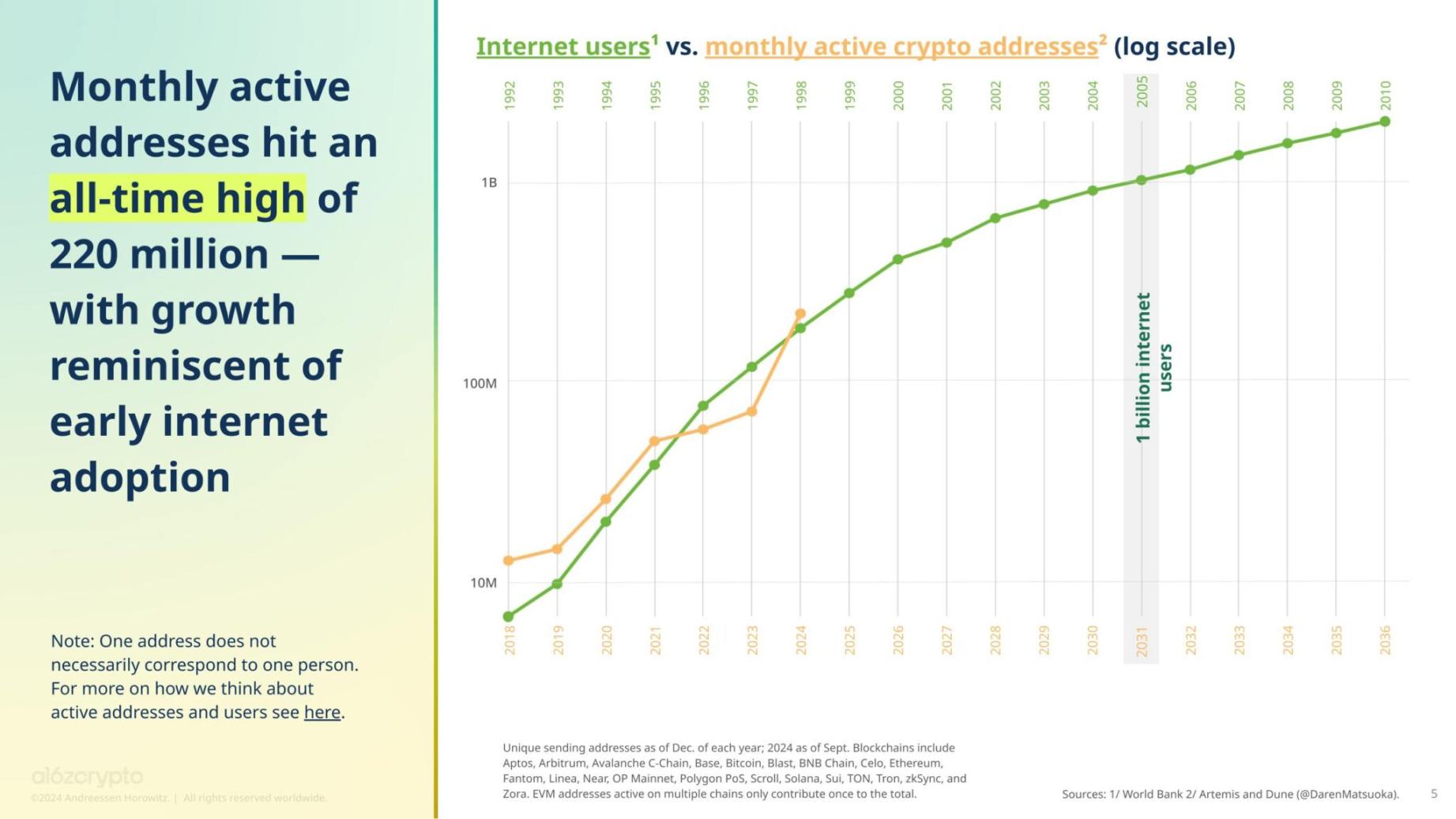
The surge in active addresses is primarily attributed to Solana, which accounts for about 100 million active addresses. Following closely are NEAR (31 million), Coinbase's popular Layer 2 network Base (22 million), Tron (14 million), and Bitcoin (11 million). Among Ethereum EVM chains, the second highest activity after Base is Binance's BNB Chain (10 million), followed by Ethereum (6 million). (Note: To calculate the total of 220 million, EVM chain addresses have been deduplicated by public key.)
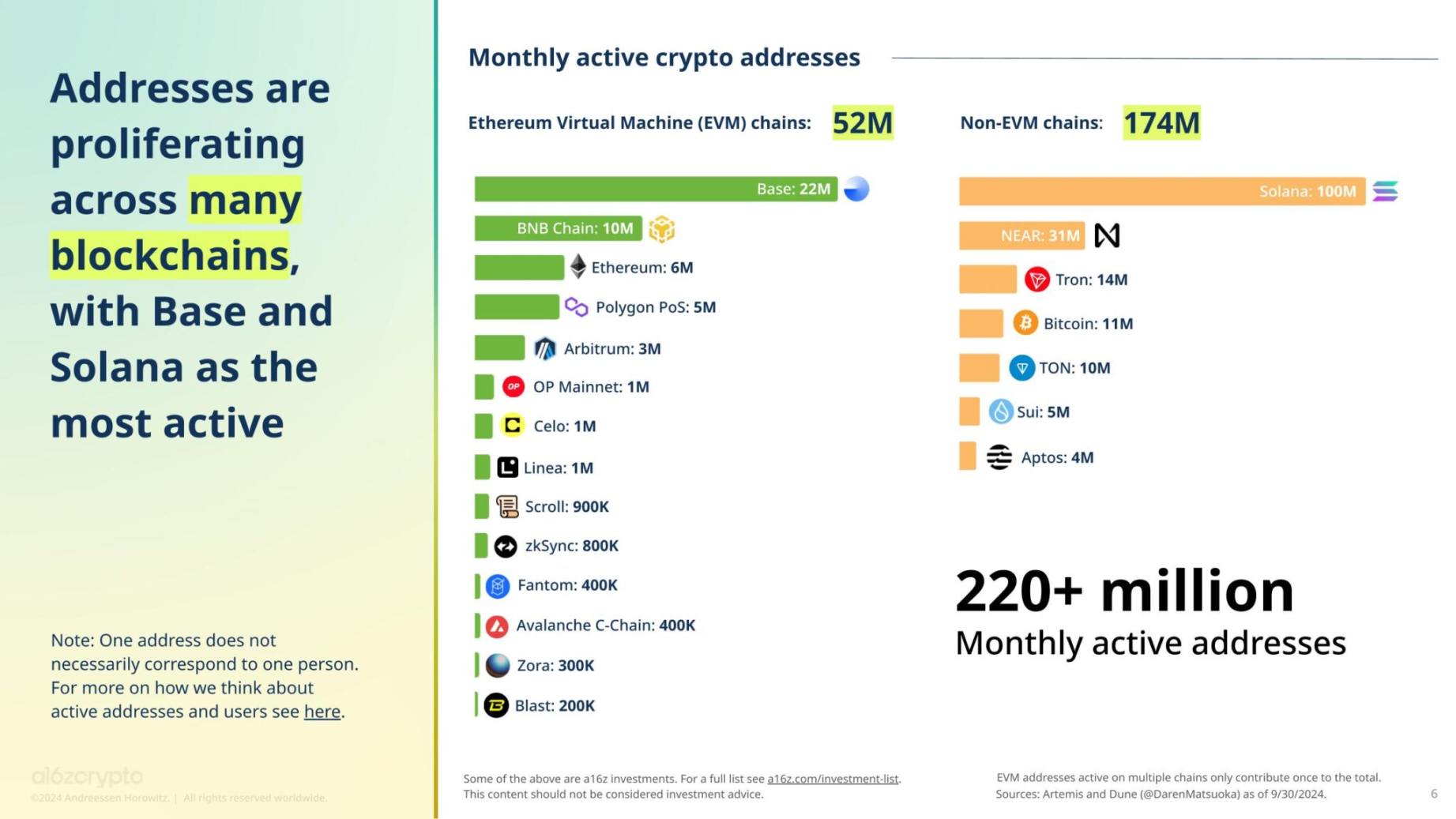
These trends are also reflected in our builder dashboard. The blockchain with the largest change in total builder interest is Solana. Specifically, the total share of founders indicating they are building or intend to build on Solana increased from 5.1% last year to 11.2% this year. Base saw the second largest increase, with its total share rising from 7.8% last year to 10.7%. Bitcoin ranks third, with its total share increasing from 2.6% last year to 4.2%.

In absolute terms, Ethereum still attracts the largest share of builder interest at 20.8%, followed by Solana and Base. Other notable mentions include Polygon (7.9%), Optimism (6.7%), Arbitrum (6.2%), Avalanche (4.2%), and Bitcoin (4.2%).
Meanwhile, the number of monthly mobile cryptocurrency wallet users reached a historic high of 29 million in June 2024. The U.S. leads with a 12% share of monthly mobile wallet users, but its share of total users has declined in recent years due to the global increase in cryptocurrency adoption and more projects seeking compliance by excluding the U.S. through geographic restrictions.
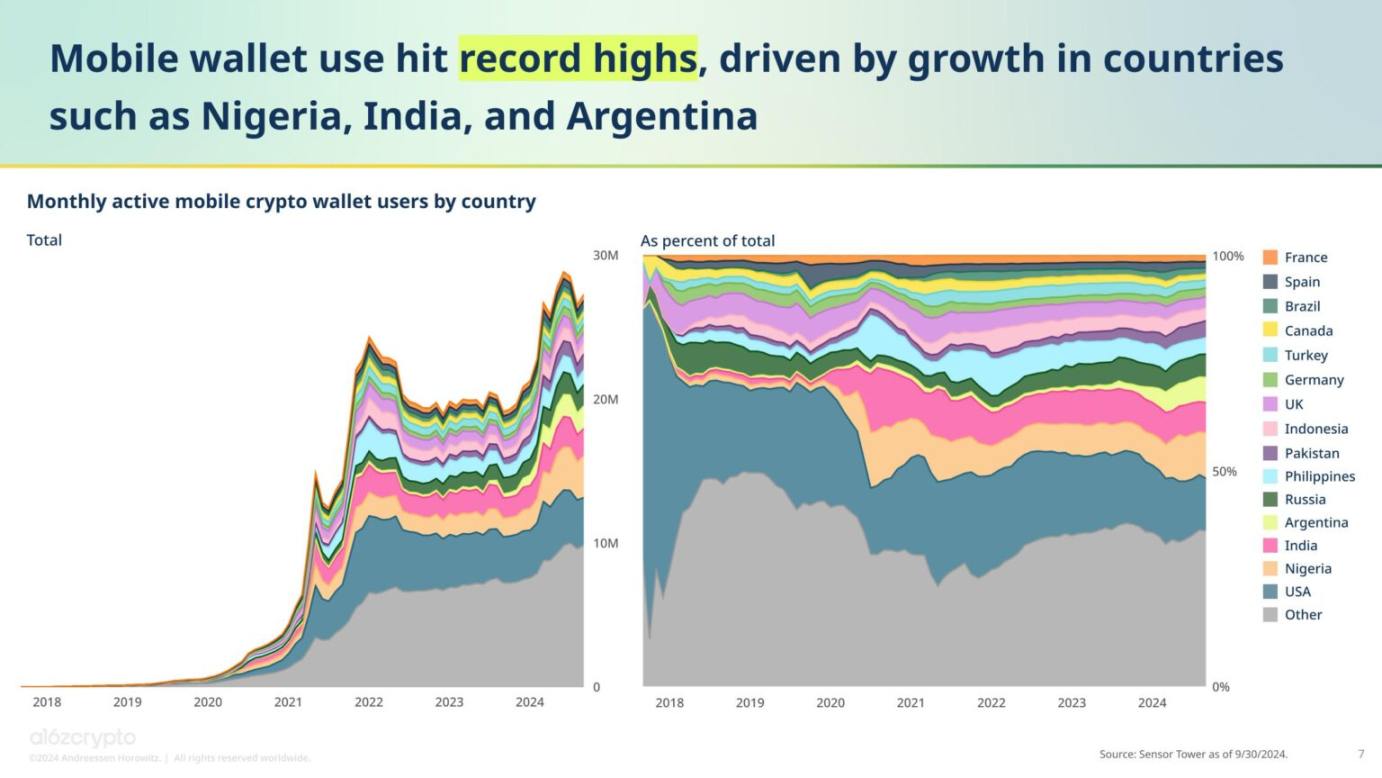
Cryptocurrency's global influence continues to expand. After the U.S., the countries with the largest shares of mobile wallet users include Nigeria (where the government seeks to provide regulatory clarity, leading to significant growth in consumer use in bill payments and retail shopping), India (with a booming population and smartphone penetration), and Argentina (where many residents are turning to cryptocurrency, especially stablecoins, amid currency devaluation).
While measuring active addresses and mobile wallet users is relatively straightforward, measuring the actual number of active users is more complex. By combining various methods, we estimate that the number of monthly active cryptocurrency users globally is between 30 million and 60 million, accounting for only 5% to 10% of the estimated 617 million global cryptocurrency owners as of June 2024 according to Crypto.com.
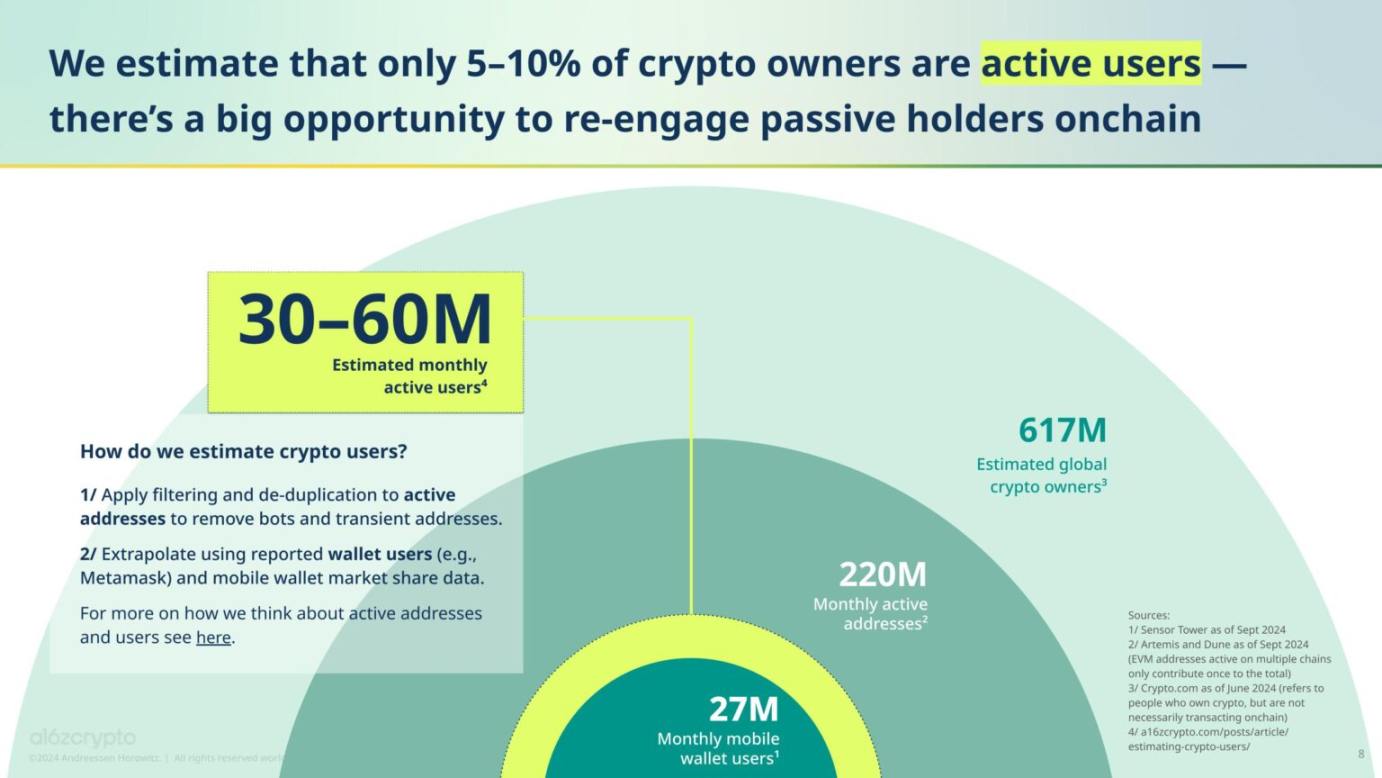
This gap highlights the significant opportunity to attract and reactivate passive cryptocurrency holders. As infrastructure improvements enable new and engaging applications and consumer experiences, more dormant holders may convert into active on-chain users.
2. Cryptocurrency has become a key political issue ahead of the U.S. elections
In this election cycle, cryptocurrency has entered the national discussion.
We measured the relative interest levels in cryptocurrency in swing states. Pennsylvania and Wisconsin are expected to be the two battleground states with the most competitive races in November. Since the last election in 2020, the increase in cryptocurrency search interest (calculated as a percentage of total Google Trends searches) ranks fourth and fifth, respectively. Michigan ranks eighth, while Georgia remains stable. Interest in Arizona and Nevada has moderately declined since 2020.
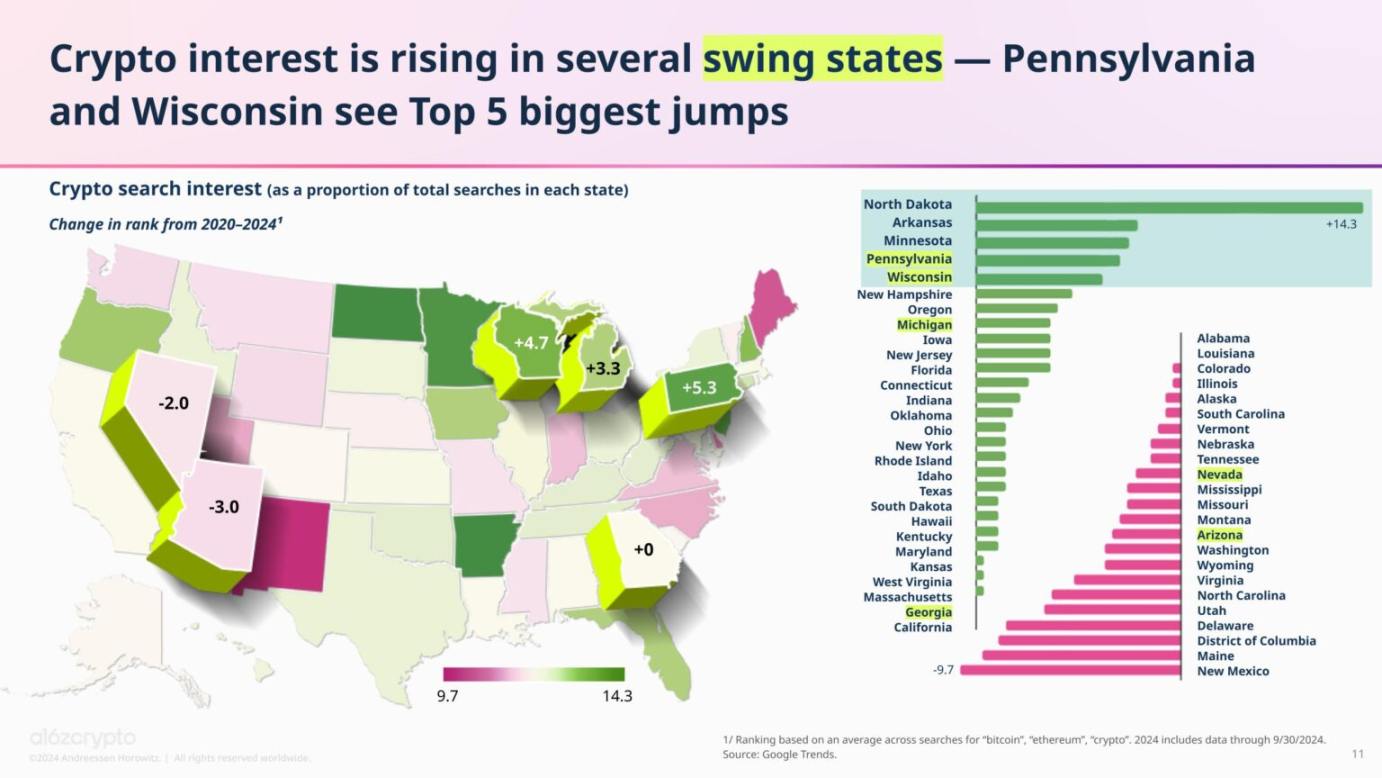
Factors that may boost public interest in cryptocurrency this year include the launch of Bitcoin and Ethereum exchange-traded products. As these ETPs broaden access for investors, the number of Americans holding cryptocurrency may increase. Bitcoin and Ethereum ETPs collectively hold $65 billion in on-chain assets. (Note: Although commonly referred to as ETFs, these products are actually registered as ETPs using SEC S-1 forms, indicating that their underlying portfolios do not contain securities.)
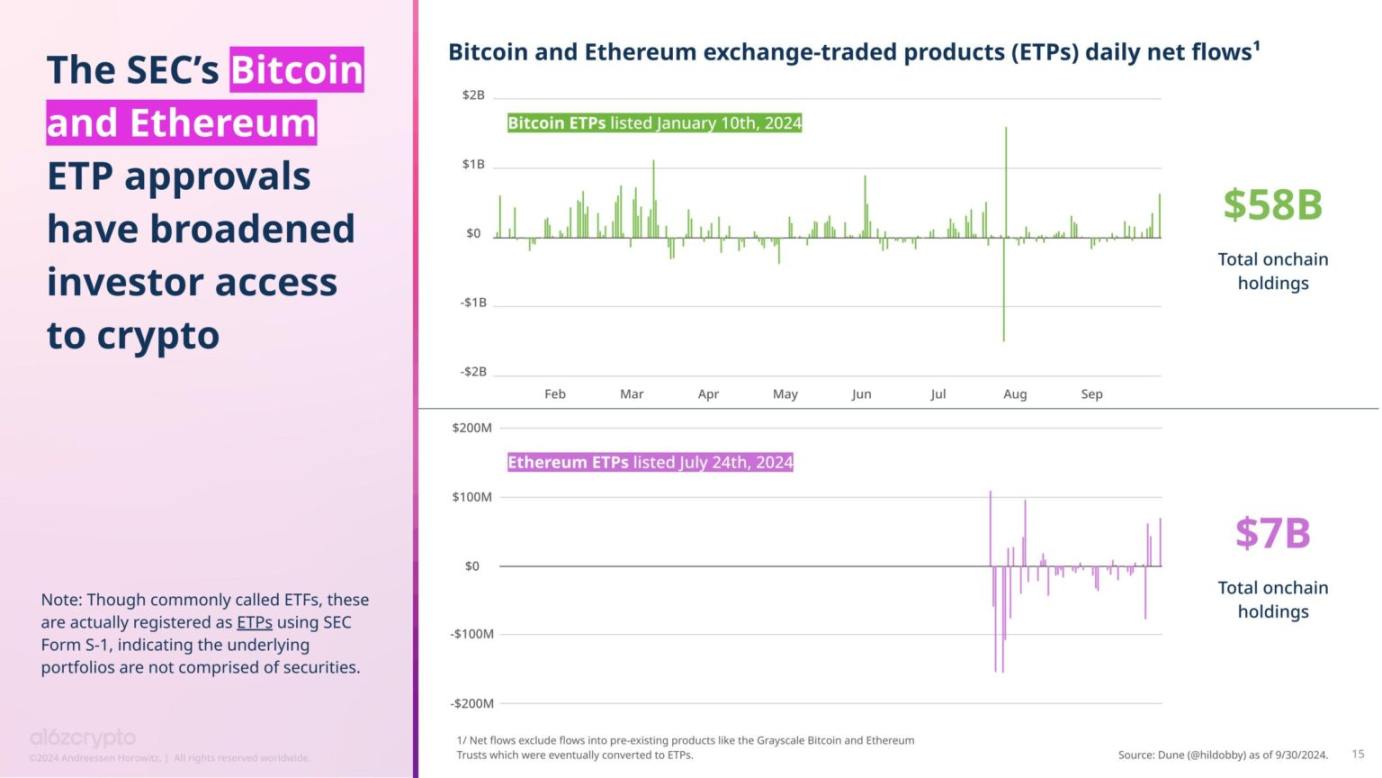
The SEC's approval of ETPs is a significant milestone for cryptocurrency policy. Regardless of which party wins in November, many politicians expect that momentum will increase with the passage of bipartisan cryptocurrency legislation. An increasing number of policymakers and politicians from both parties are expressing positive views on cryptocurrency.
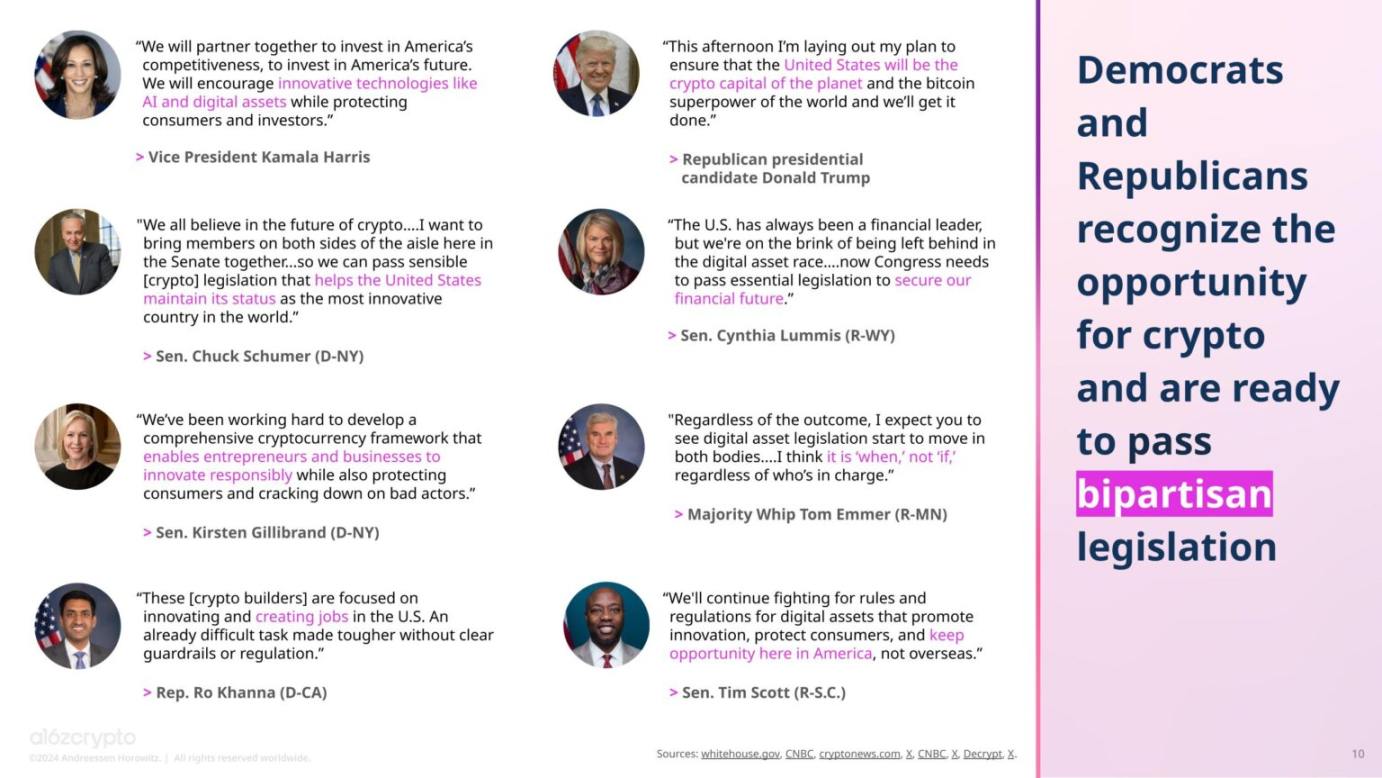
This year, the cryptocurrency industry has also driven other significant progress at the policy level. At the federal level, the House passed the "21st Century Financial Innovation and Technology Act" with bipartisan support (208 Republicans and 71 Democrats in favor). After Senate review and approval, this bill is expected to provide much-needed regulatory clarity for cryptocurrency entrepreneurs.
Equally important are the advancements at the state level, where Wyoming has passed the "Decentralized Non-Profit Corporation Act." This law grants legal recognition to decentralized autonomous organizations, allowing blockchain networks to operate legally while maintaining their decentralized characteristics.
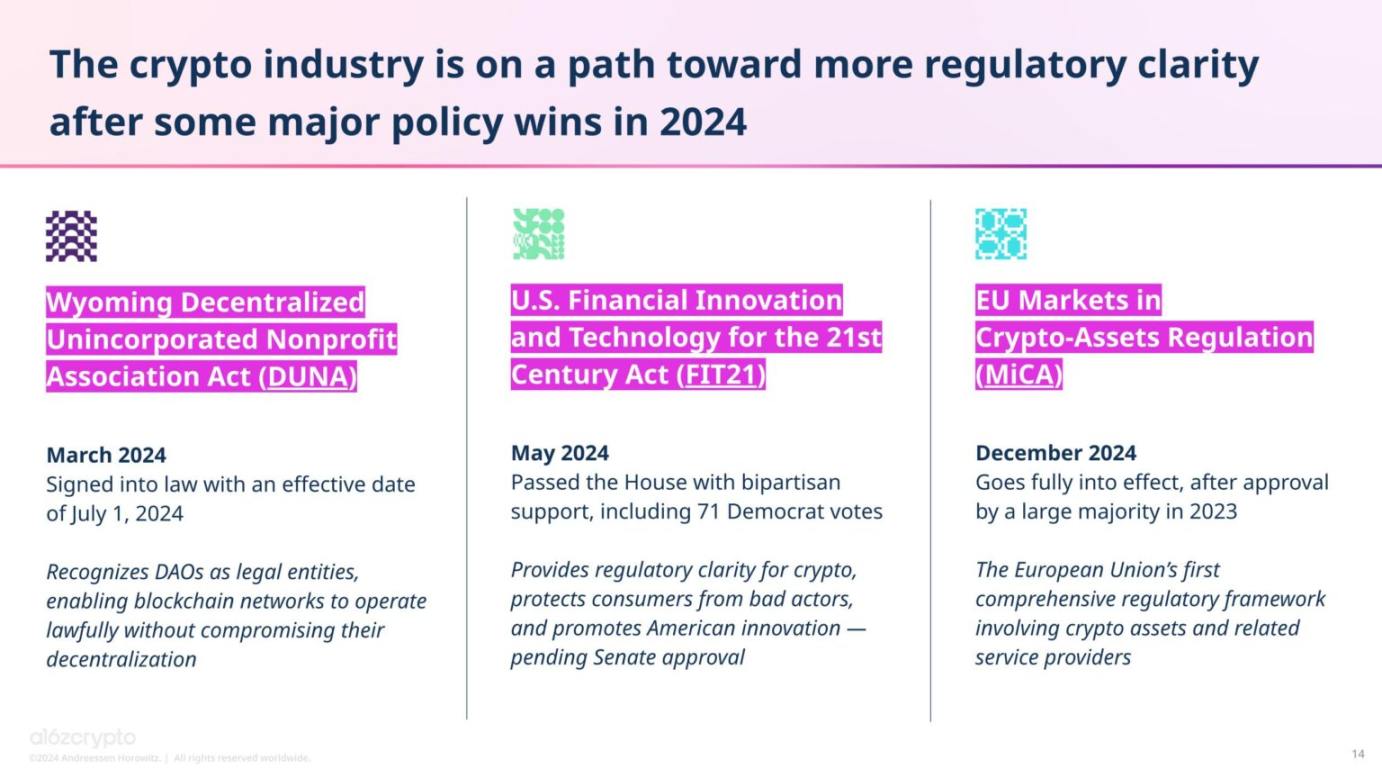
The EU and the UK have been the most proactive in involving the public in discussions about cryptocurrency policy and regulation. Various European institutions have issued far more consultations than agencies like the U.S. Securities and Exchange Commission. At the same time, the EU's "Crypto-Asset Markets Regulation" is the first comprehensive regulatory framework for cryptocurrency to come into full effect, set to be fully implemented by the end of the year.
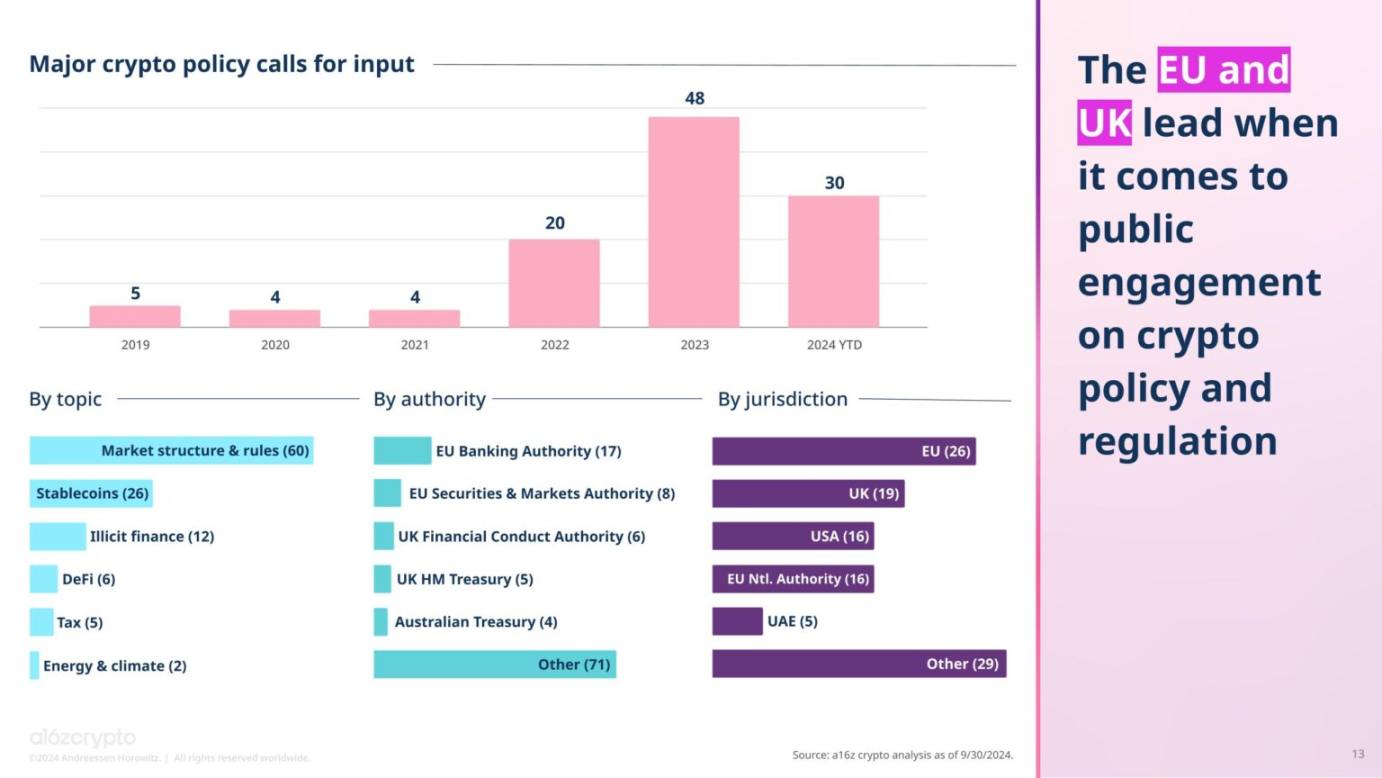
Stablecoins have become one of the most popular cryptocurrency products and a hot topic of policy discussion, with several related bills circulating in Congress. At least in the U.S., one of the driving factors is the recognition that stablecoins can reinforce their international standing amid the decline of the dollar's status as the global reserve currency. Currently, over 99% of stablecoins are denominated in dollars, far exceeding the second-largest currency, the euro (0.20%).
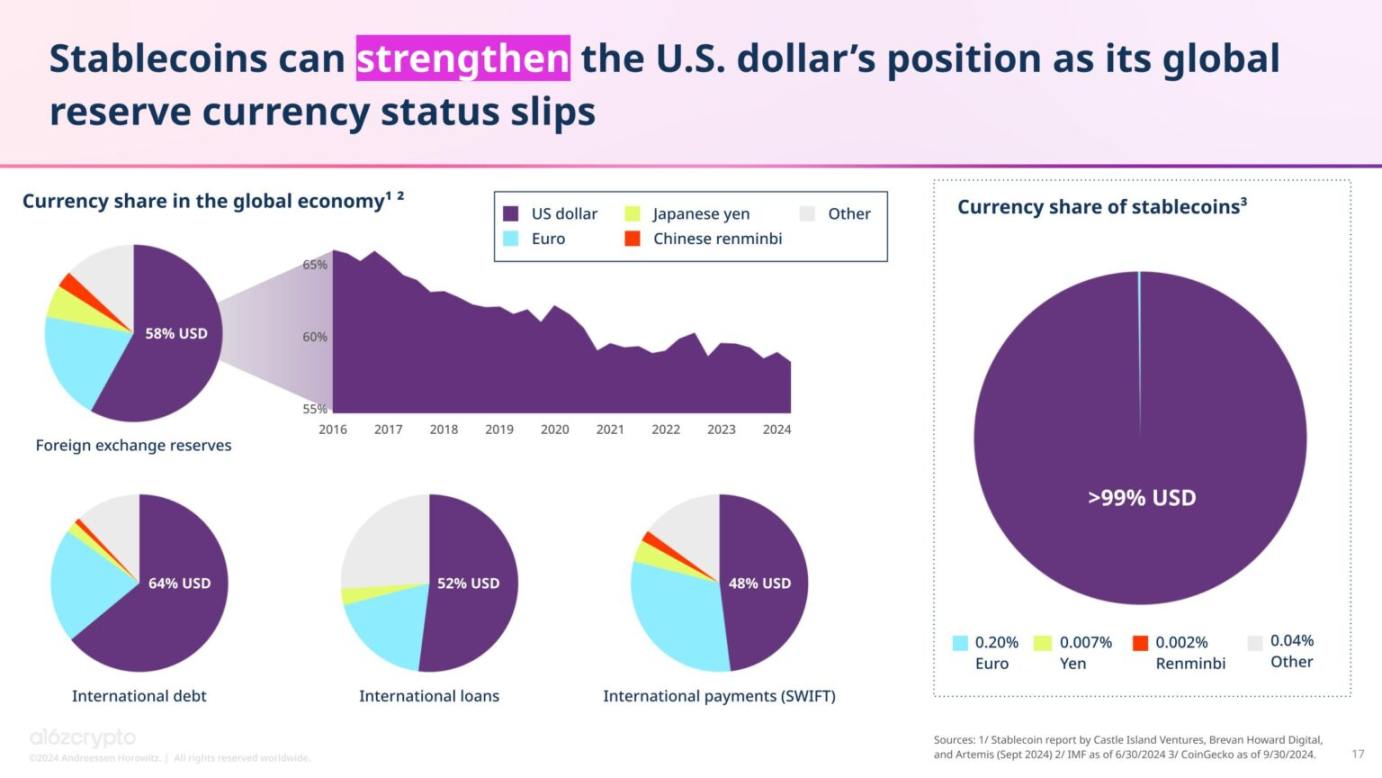
In addition to showcasing the strength of the dollar globally, stablecoins may also strengthen the domestic financial foundation in the U.S. Despite being only a decade old, stablecoins have already become one of the top 20 holders of U.S. debt, surpassing countries like Germany.
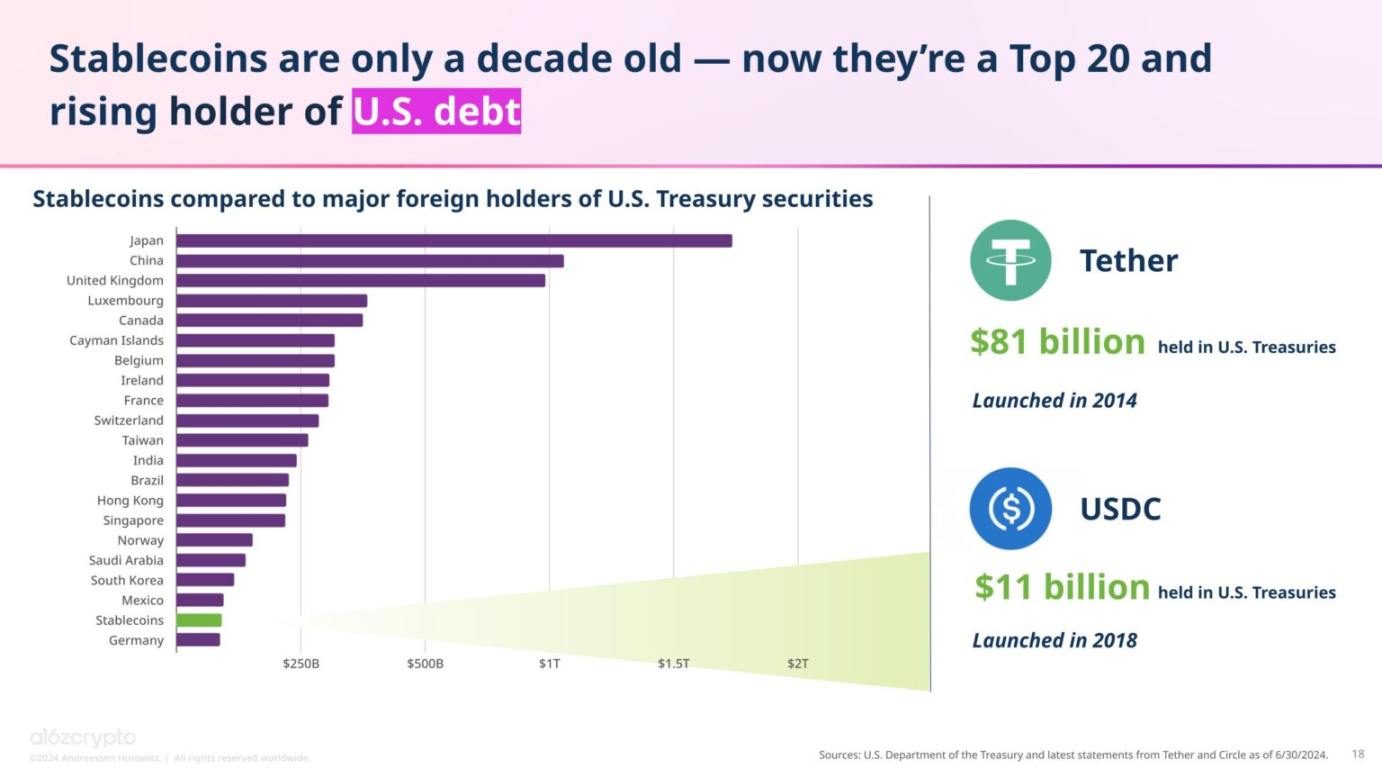
While some countries are exploring central bank digital currencies, the opportunity for stablecoins in the U.S. is already ripe. Given these discussions and the attention from numerous political figures towards cryptocurrency, we expect more countries to begin seriously formulating their cryptocurrency policies and strategies.
3. Stablecoins have found product-market fit
With the ability to enable fast, cheap, and global payments, stablecoins have become one of the most significant "killer applications" in cryptocurrency. As Congressman Ritchie Torres (D-NY) wrote in a September column for the New York Daily News, "The proliferation of dollar stablecoins could become the greatest financial empowerment experiment in human history."
Major scaling upgrades have significantly reduced the transaction costs of cryptocurrencies (including transactions involving stablecoins), with some cases seeing reductions of over 99%. On Ethereum, the average gas fee for transactions involving the popular stablecoin USDC this month was $1, down from an average of $12 in 2021. Sending USDC on Coinbase's Layer 2 network Base costs less than a cent on average. (Note: These figures may not include certain access and exit costs.)
In contrast, the average cost of an international wire transfer is $44.

Stablecoins make value transfer convenient. In the second quarter of 2024, ending June 30, stablecoin transaction volume reached $8.5 trillion, processing 1 billion transactions. Its transaction volume is more than double that of Visa during the same period ($3.9 trillion). Stablecoins can stand alongside well-known payment services like Visa, PayPal, ACH, and Fedwire, fully demonstrating their utility.
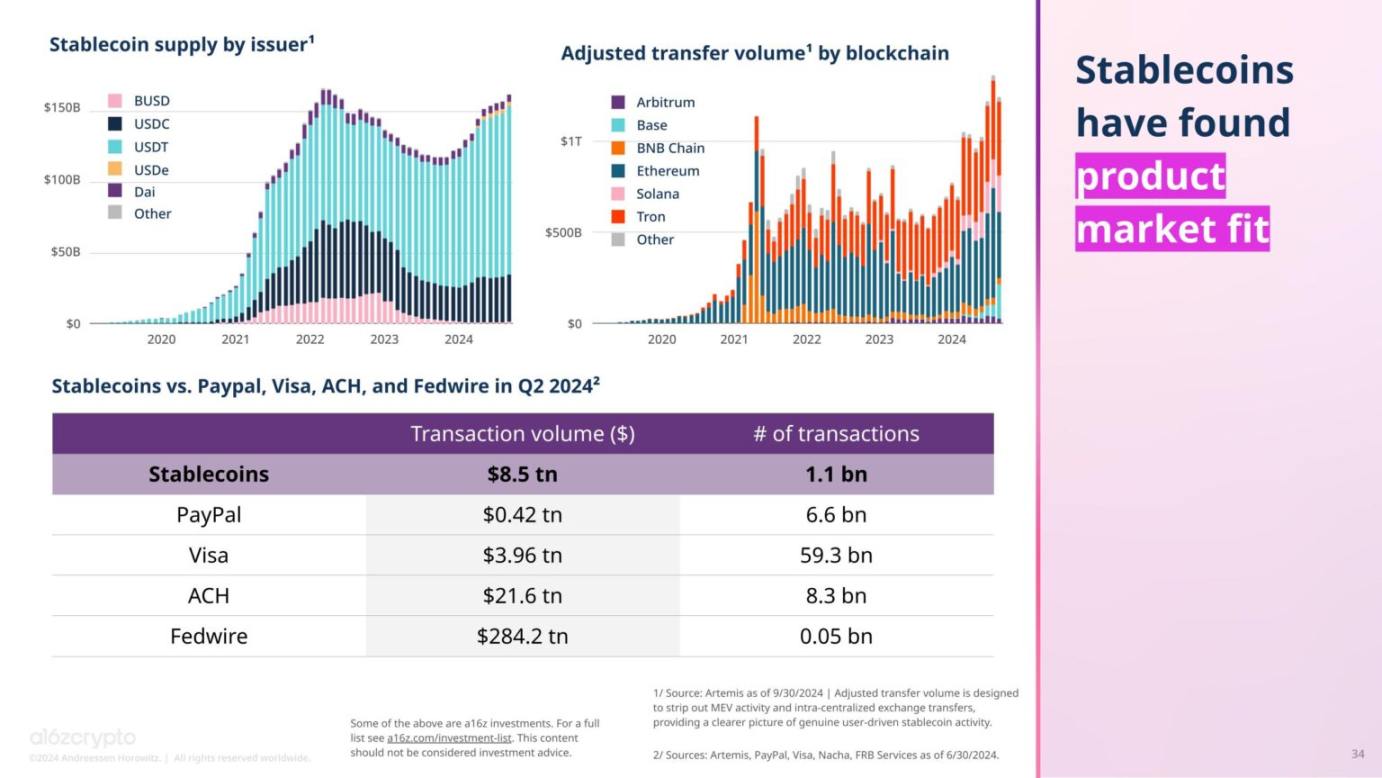
Stablecoins are not a passing fad. Comparing stablecoin activity with the volatile market cycles of cryptocurrencies shows that the two seem unrelated. In fact, even as spot cryptocurrency trading volumes decline, the number of monthly active addresses for stablecoins continues to grow, indicating that people use stablecoins for more than just trading.
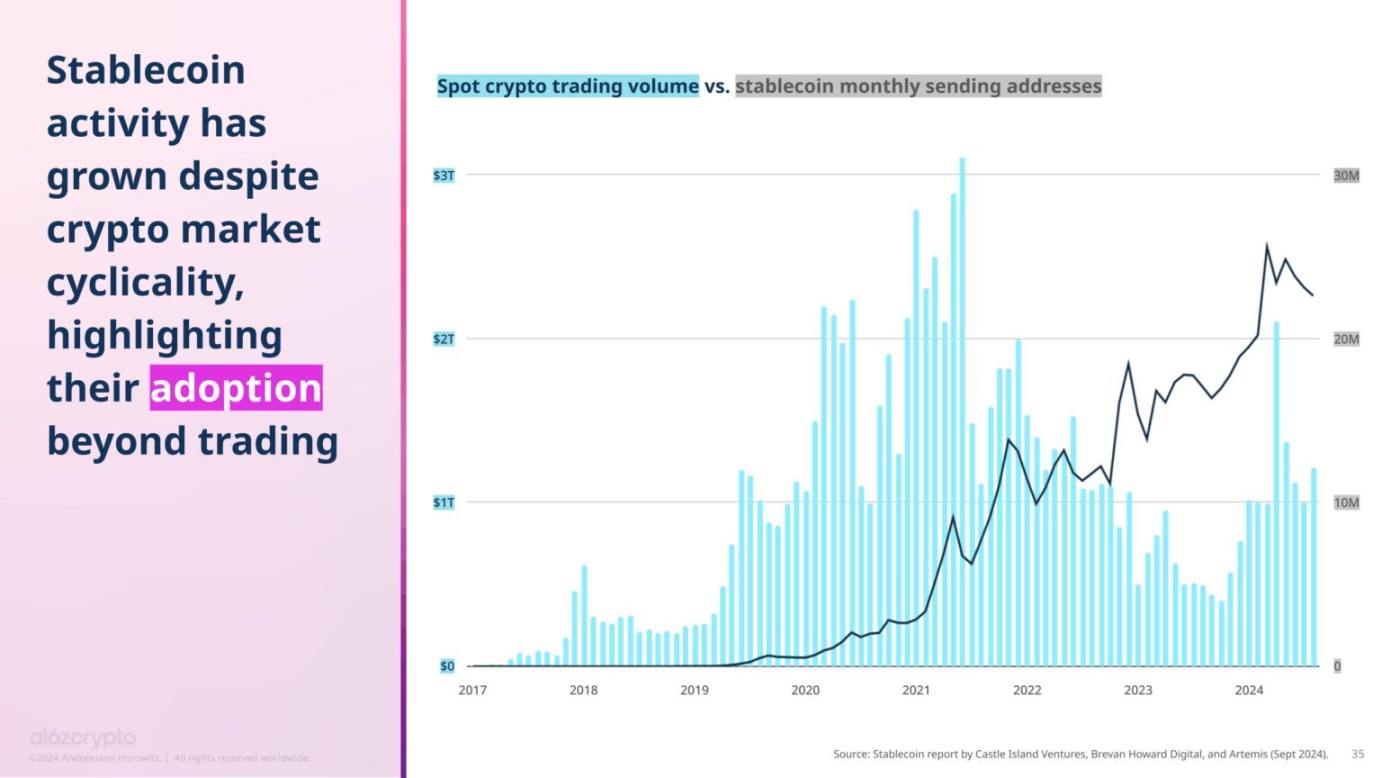
All activity is reflected in usage statistics. Calculated by the share of daily active addresses, stablecoins account for nearly one-third (32%) of daily cryptocurrency usage, second only to decentralized finance (34%). The remaining usage is spread across infrastructure, token transfers, and other areas.
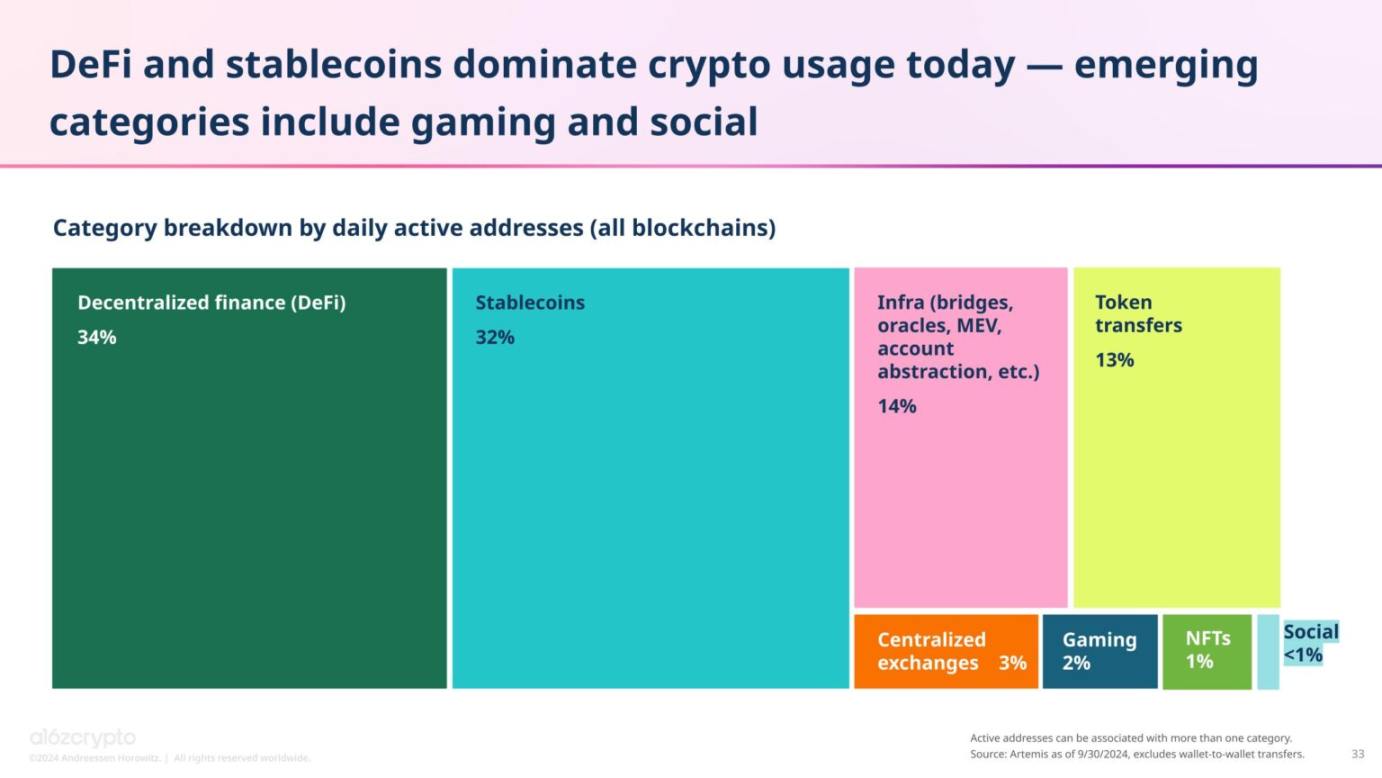
4. Infrastructure improvements have increased capacity and significantly reduced transaction costs
The popularity and ease of use of stablecoins are partly due to advancements in underlying infrastructure. First, blockchain capacity continues to grow. Thanks to the rise of Ethereum Layer 2 networks and other high-throughput blockchains, the current transaction volume processed by blockchains per second is more than 50 times that of four years ago.
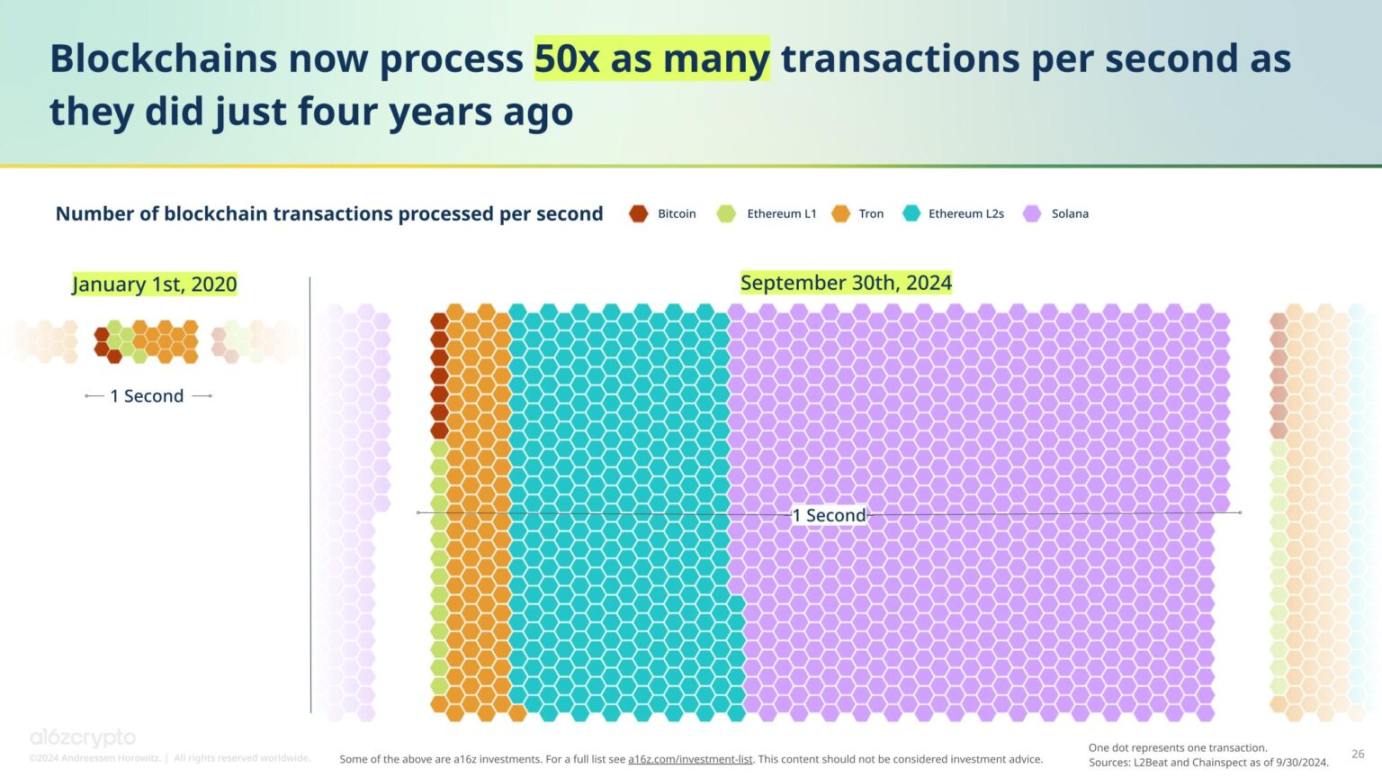
More significantly, Ethereum's most important upgrade this year, "Dencun" (EIP-4844), implemented in March 2024, has drastically reduced Layer 2 network fees. Since then, fees paid on Layer 2 on Ethereum have sharply declined, while the value priced in ETH on Layer 2 has continued to rise. This indicates that blockchain networks are becoming more popular and efficient.

The situation is similar for zero-knowledge proof technology. Although monthly spending on verifying ZK proofs on Ethereum has decreased, the value priced in ETH on ZK rollups has increased, indicating that ZK proofs are becoming more popular while costs are decreasing.
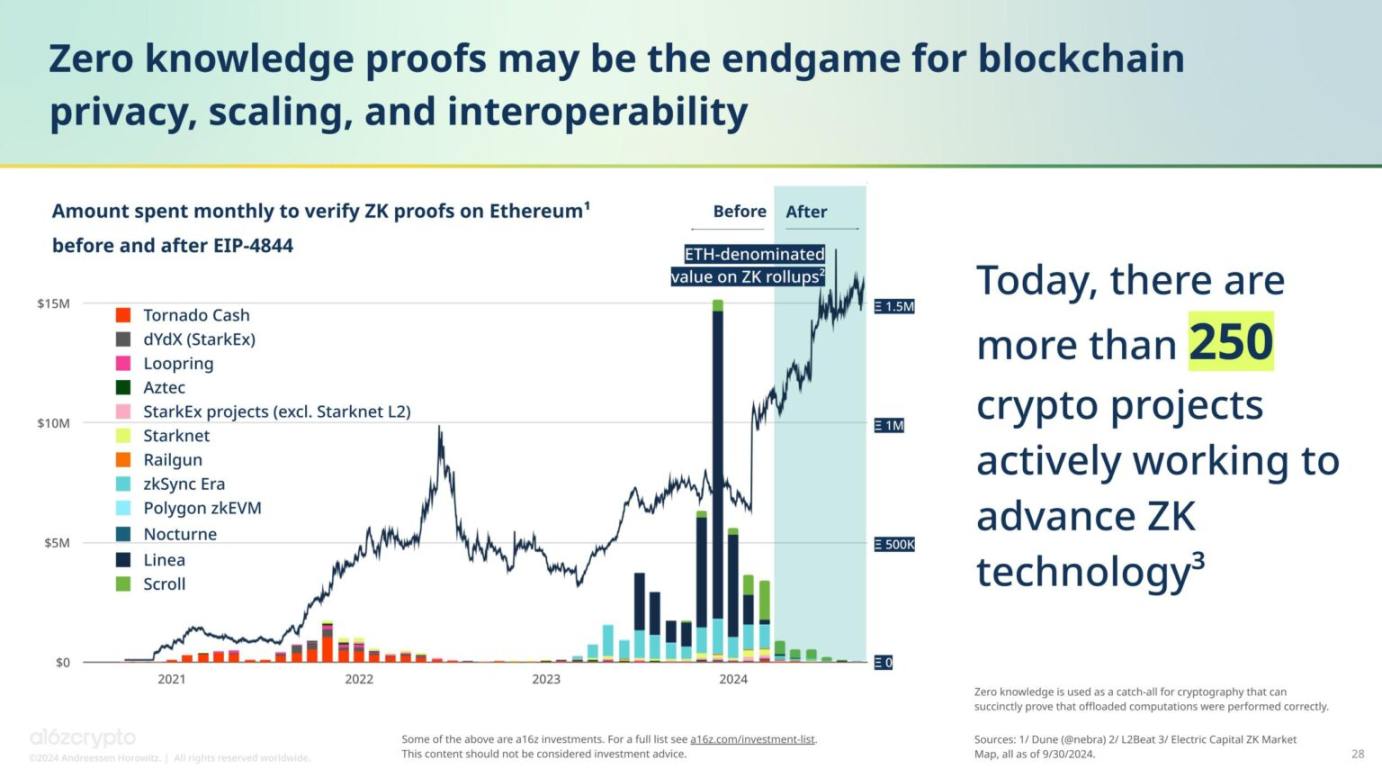
The prospects for ZK technology are broad, opening new paths for developers to achieve cheap, verifiable blockchain computation. However, ZK-based virtual machines still have a long way to go to catch up with traditional computers in terms of performance.
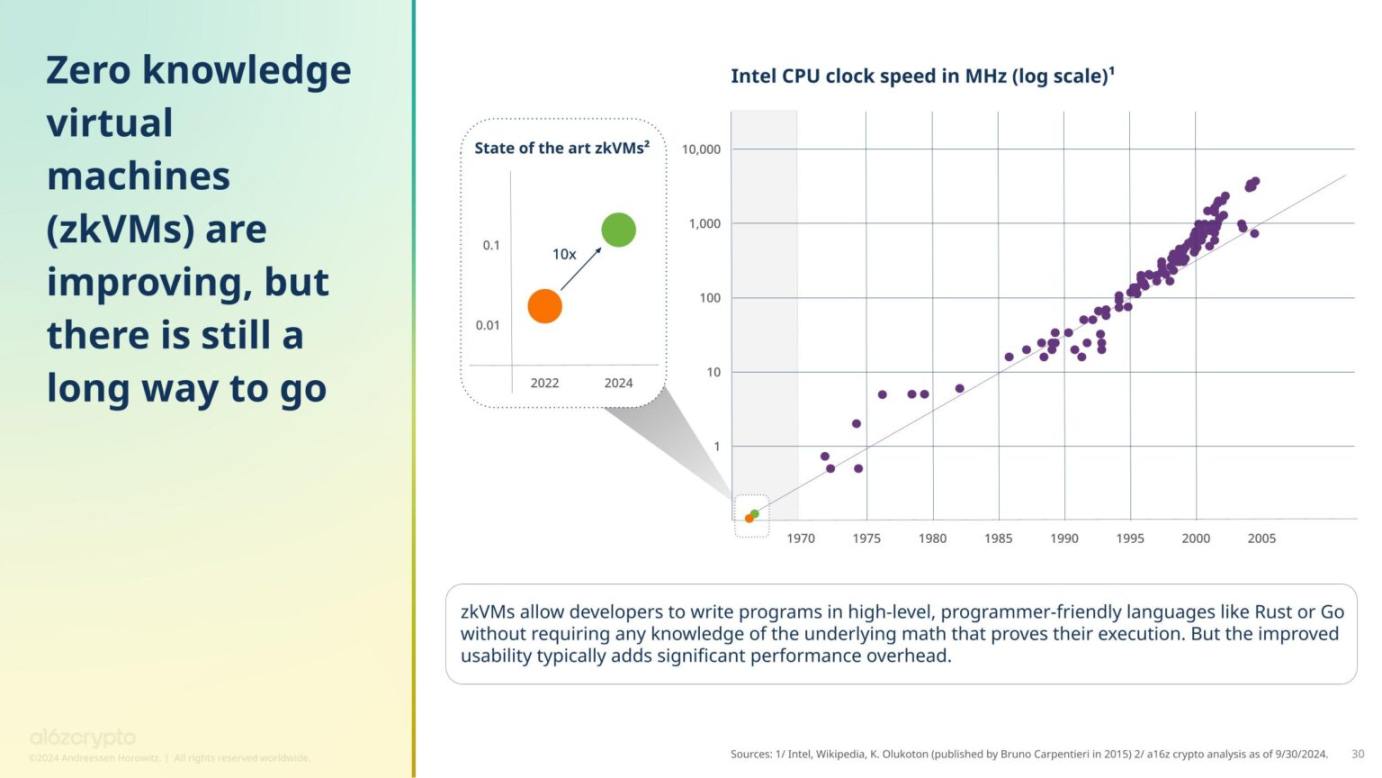
Given these infrastructure improvements, blockchain infrastructure remains one of the most popular areas for builders, with Layer 2 becoming one of the top 5 hot subcategories we track.
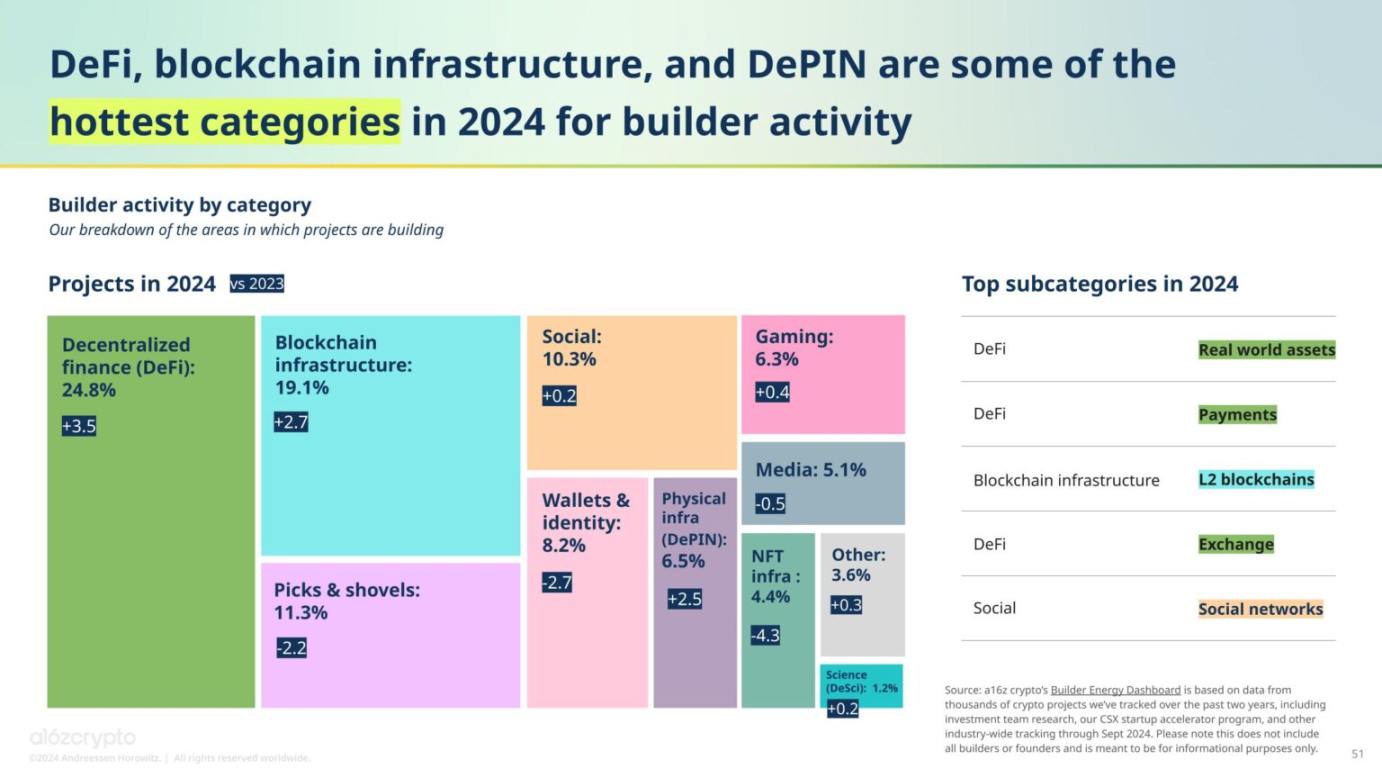
5. DeFi remains popular and continues to grow
DeFi is the only category that attracts builders more than blockchain infrastructure (which also accounts for 34% of daily cryptocurrency usage). Since the rise of DeFi in the summer of 2020, decentralized exchanges have accounted for 10% of spot cryptocurrency trading activity (whereas four years ago, all of this trading occurred on centralized exchanges).
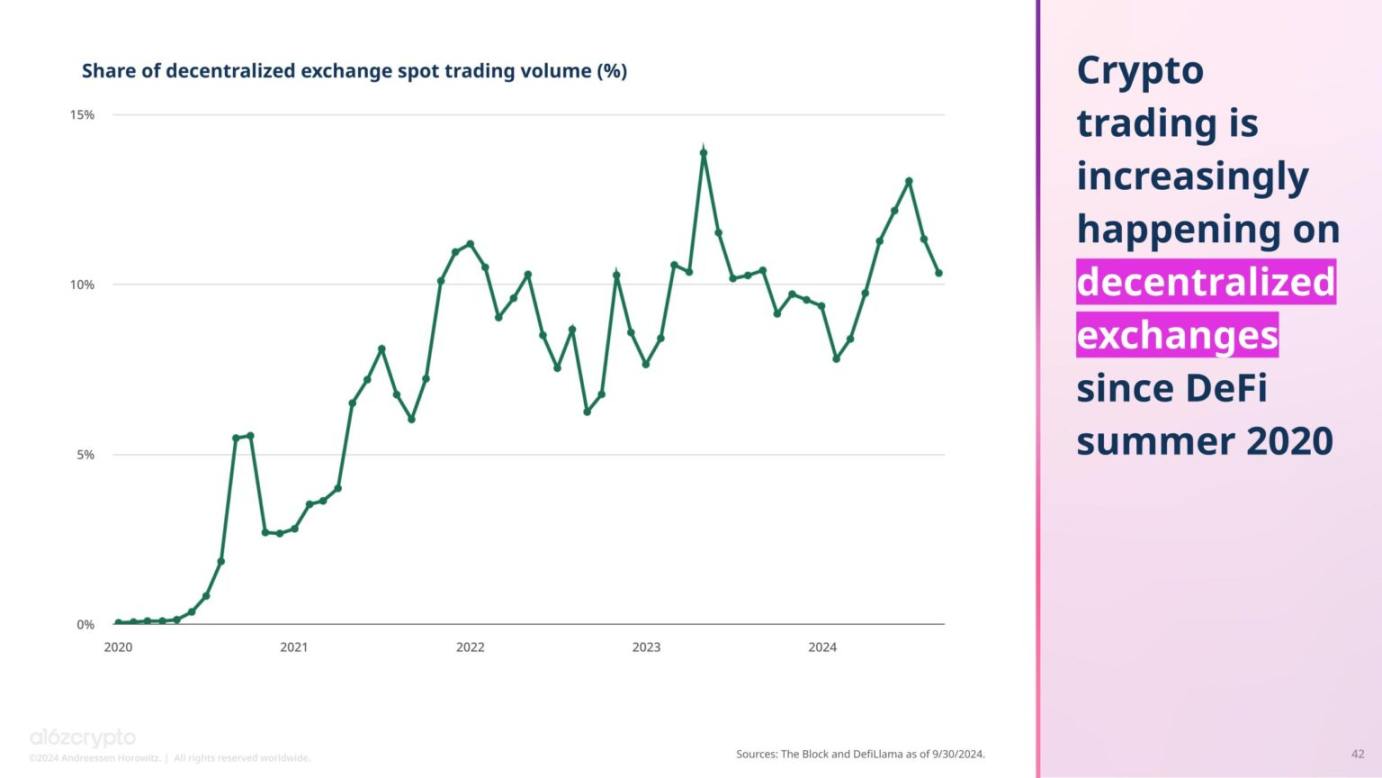
Currently, over $169 billion in assets are locked in thousands of DeFi protocols. The top DeFi subcategories include staking and lending.
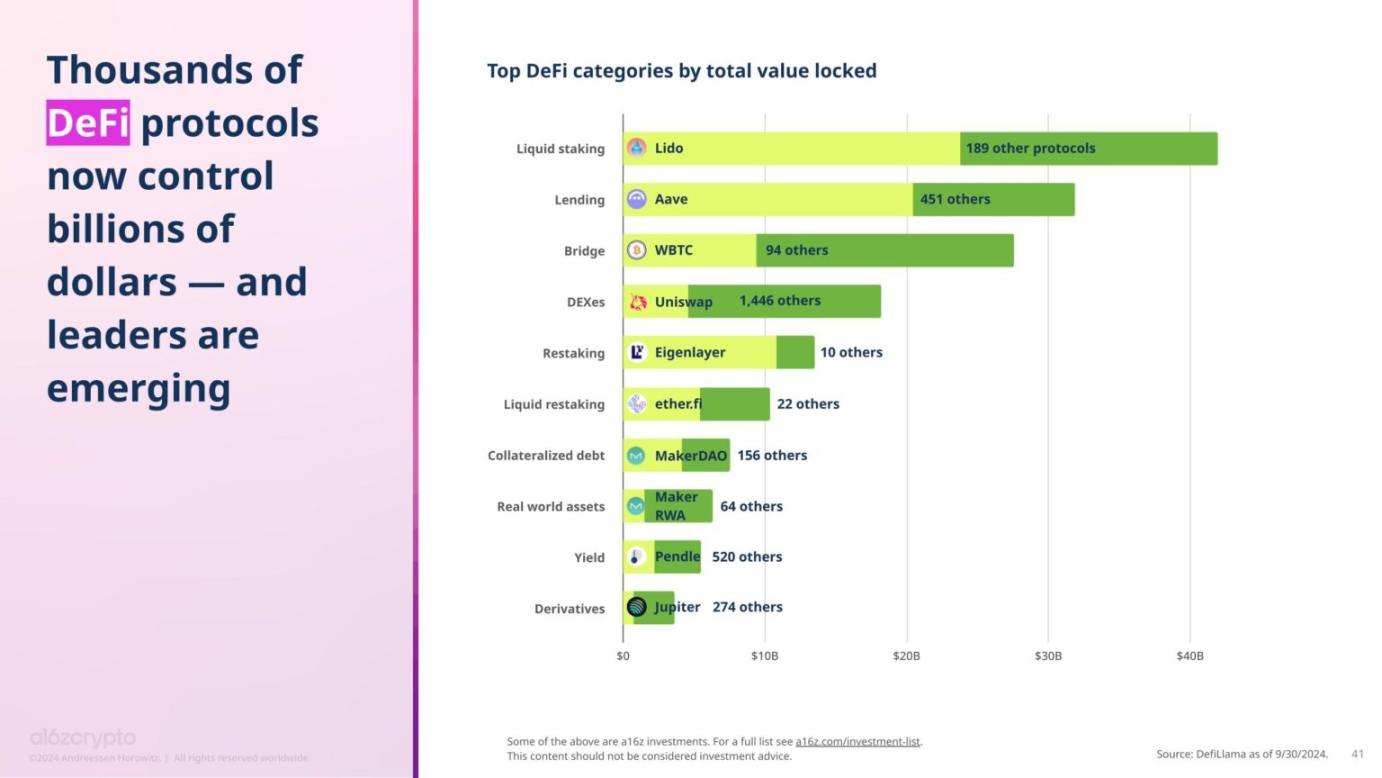
Ethereum's transition to proof-of-stake has been completed for over two years, significantly reducing network energy consumption. Since then, the share of ETH that has been staked has increased from 11% two years ago to 29%, greatly enhancing network security.
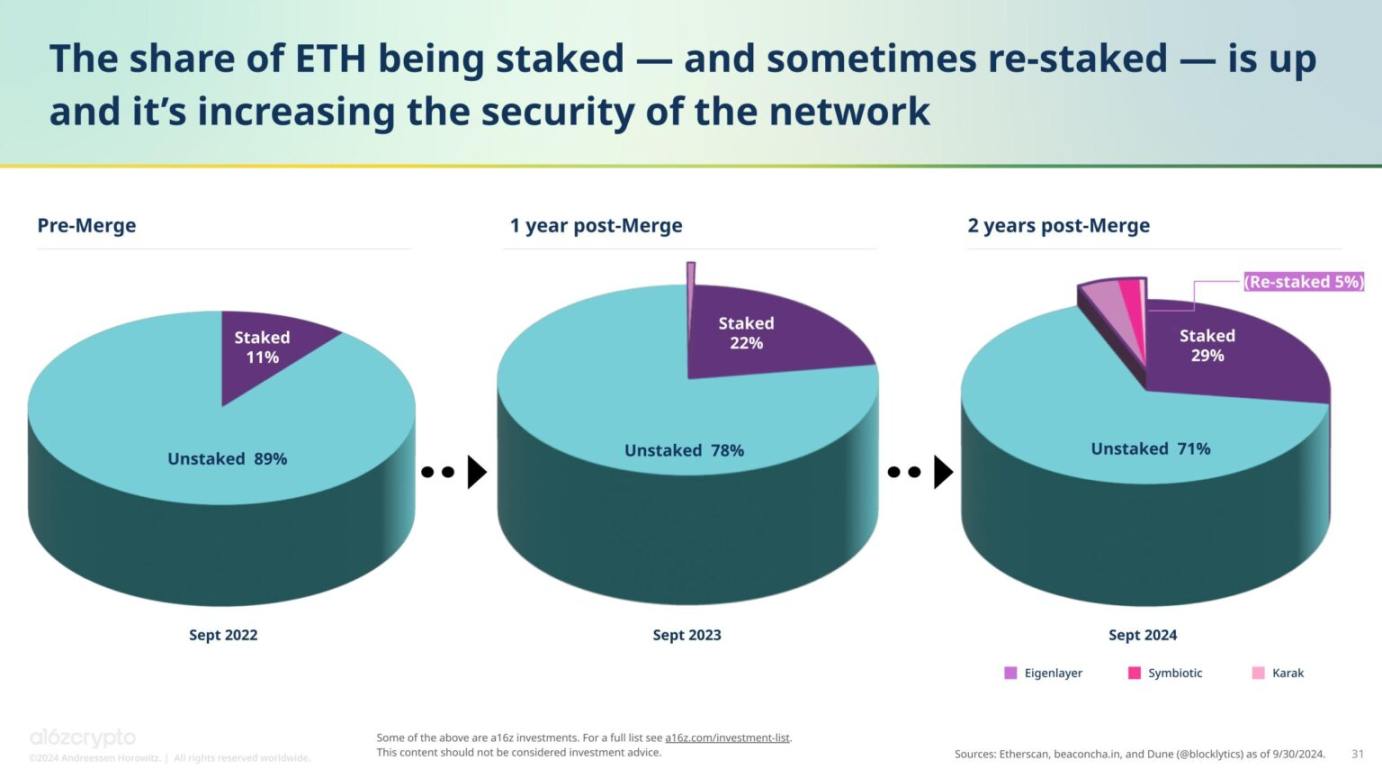
Despite being in its early stages, DeFi offers a new alternative to the increasingly centralized and power-concentrated trends in the U.S. financial system. Since 1990, the number of banks in the U.S. financial system has decreased by two-thirds, and the share of large banks in assets has also been increasing.

6. Cryptocurrency may address some urgent challenges in artificial intelligence
Artificial intelligence is one of the hottest trends this year, not only in the broader tech world but also in the cryptocurrency space.
AI is one of the most discussed trends among social media influencers in the cryptocurrency field. More surprisingly, there is a high overlap between visitors to chatgpt.com and visitors to top cryptocurrency websites, indicating a close connection between crypto users and AI users.
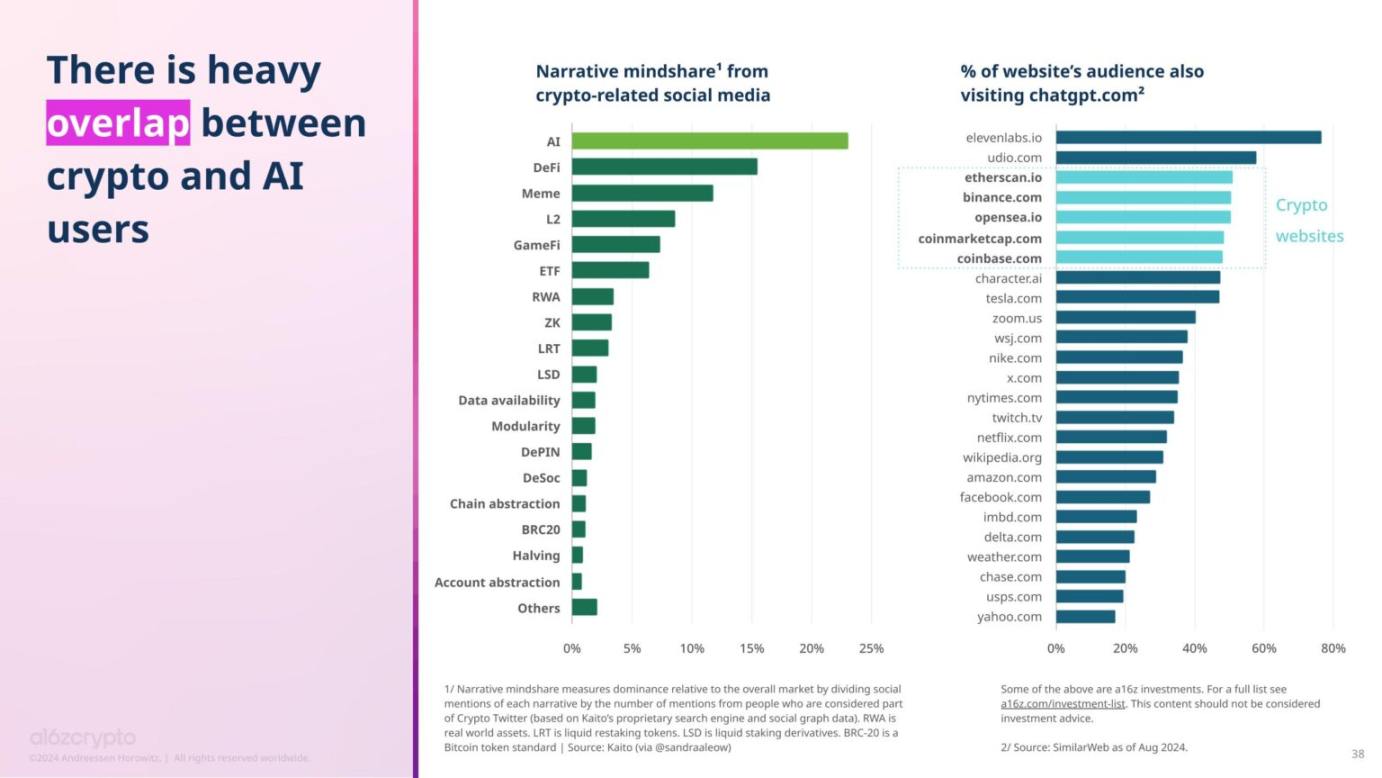
Cryptocurrency builders are closely associated with AI. According to the builder vitality dashboard, about 34% of crypto projects report using AI, up from 27% a year ago. The most popular category for applying AI technology is blockchain infrastructure projects.
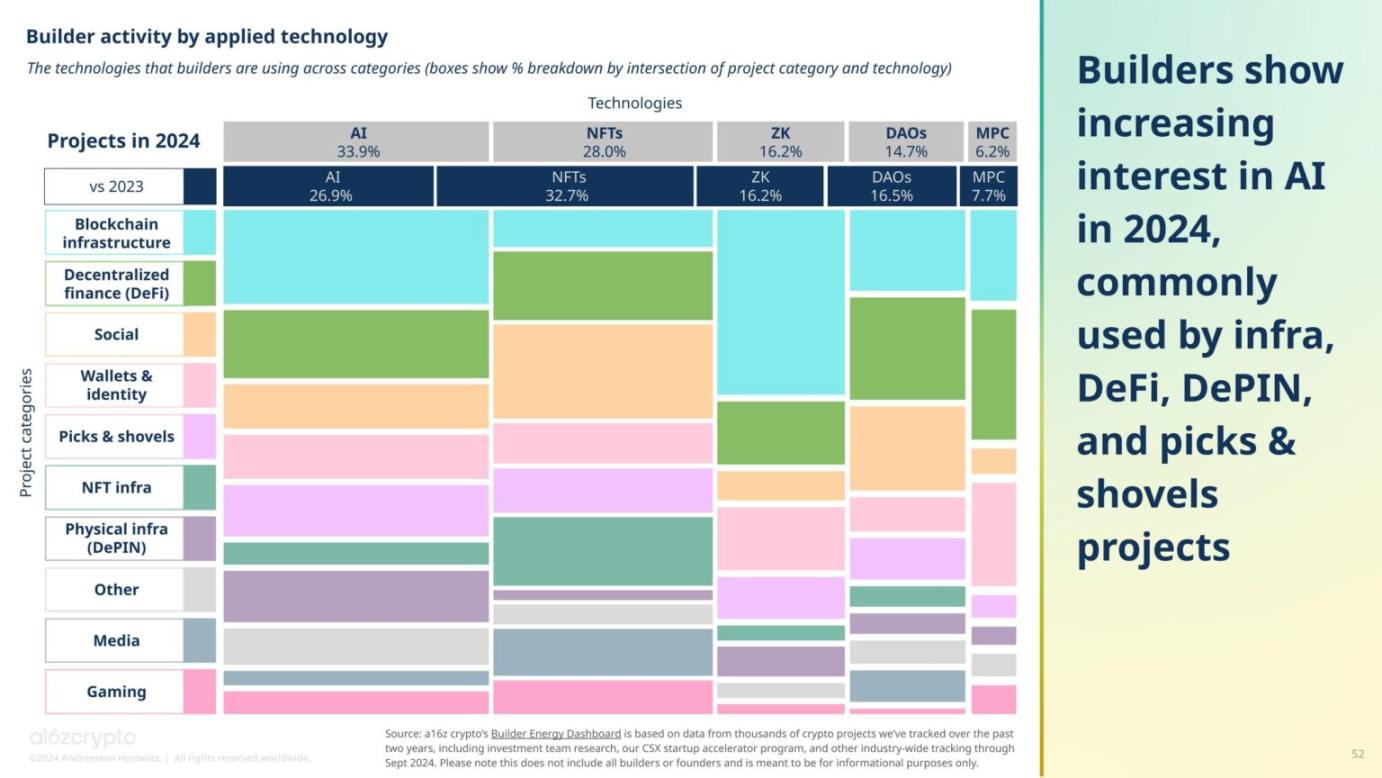
Given that the training costs for cutting-edge AI models have grown at a rate of four times per year over the past decade, we believe AI may lead to increasing centralization of power on the internet. Without constraints, only large tech companies may have the resources to train the latest models.
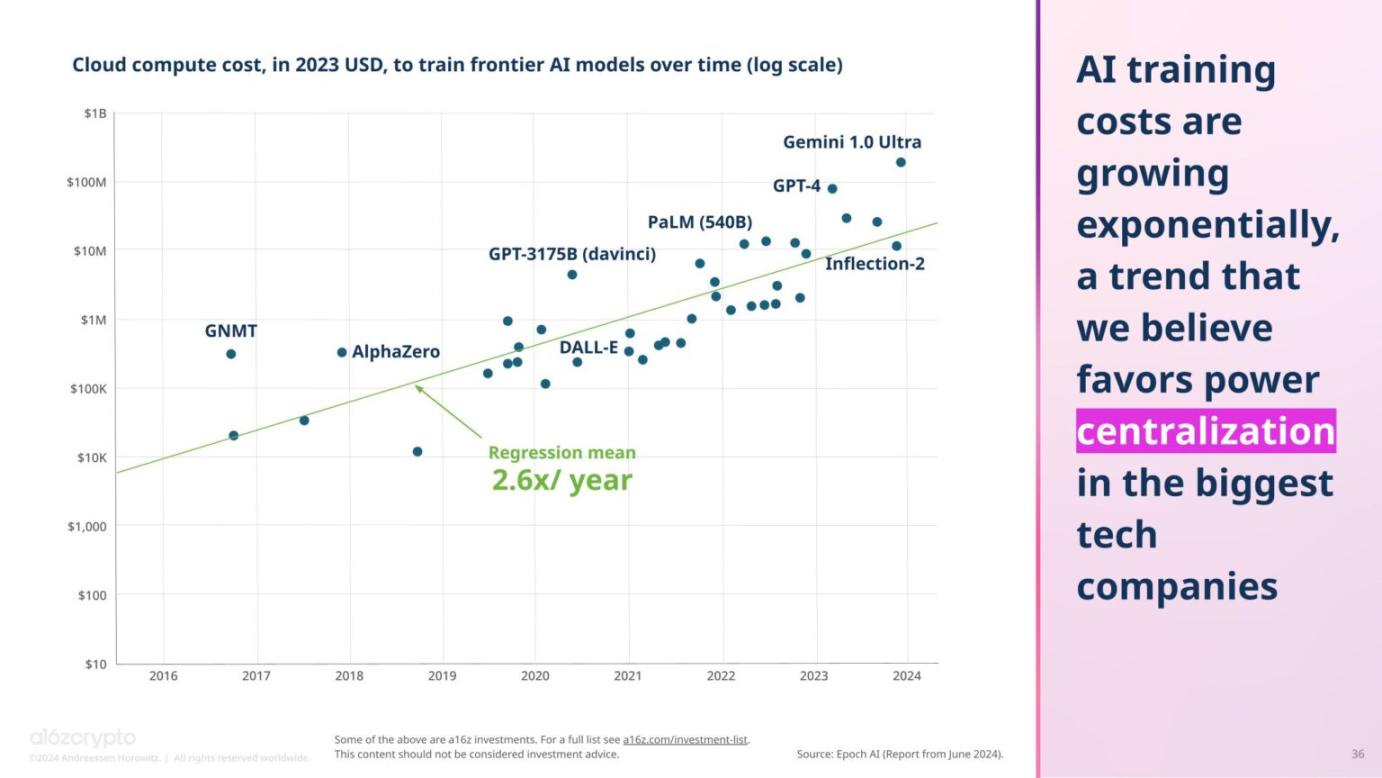
The centralization challenges of AI starkly contrast with the decentralization opportunities offered by blockchain networks. Crypto projects are already attempting to address these challenges, such as Gensyn, Story, Near, and Starling Labs.
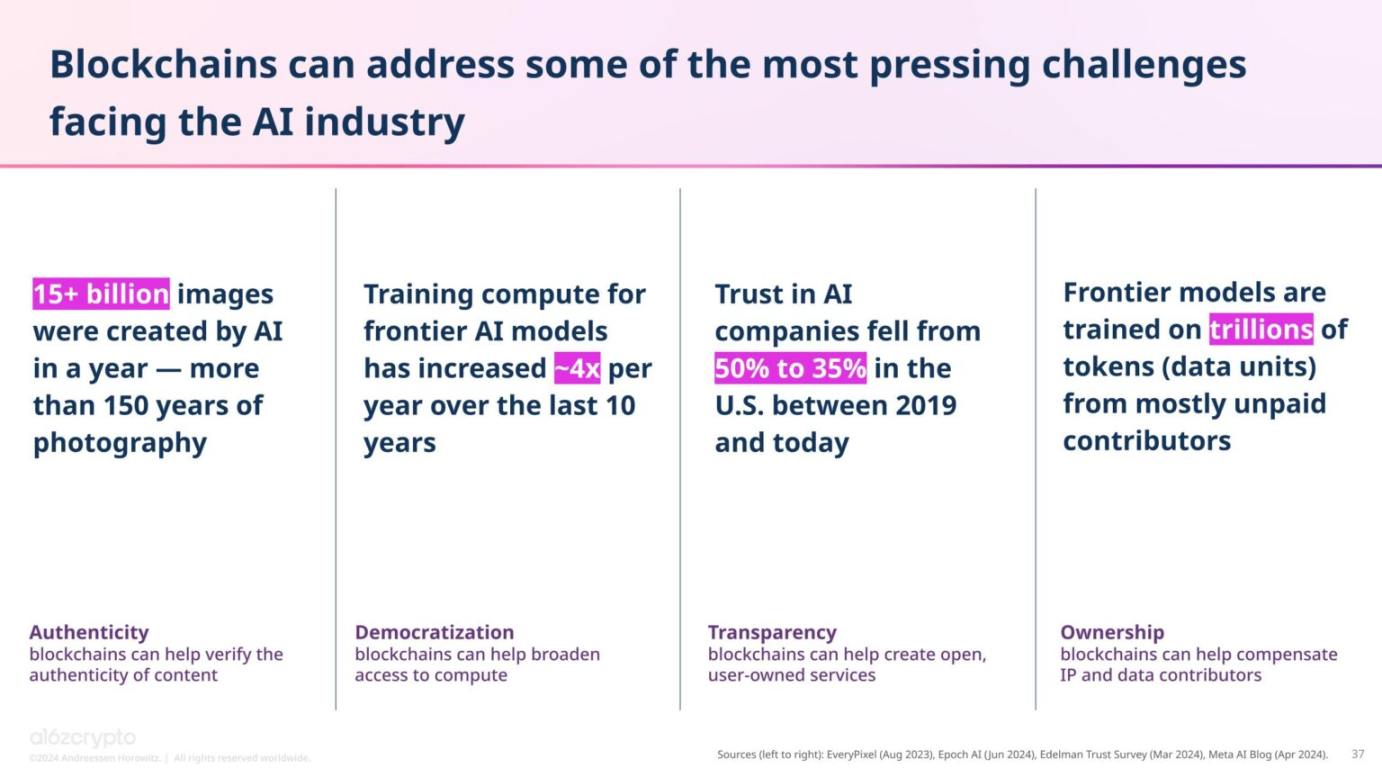
In the coming years, the intersection of cryptocurrency and AI may strengthen.
7. More scalable infrastructure unlocks new on-chain applications
As transaction costs decrease and blockchain capacity increases, many previously difficult-to-implement cryptocurrency consumer applications are becoming possible.
For example, NFTs saw massive trading volumes in the secondary market when transaction costs were high a few years ago. Since then, that activity has waned, replaced by new consumer behaviors of minting low-cost NFT collections on social applications like Zora and Rodeo. This represents a significant shift in the NFT market that was unimaginable before transaction fees were drastically reduced.

Social networks are another example. Although they currently account for only a small portion of daily on-chain activity, they have attracted strong builder vitality: 10.3% of crypto projects in 2024 are related to social applications. In fact, social network projects related to Farcaster are among the top 5 hot subcategories this year.
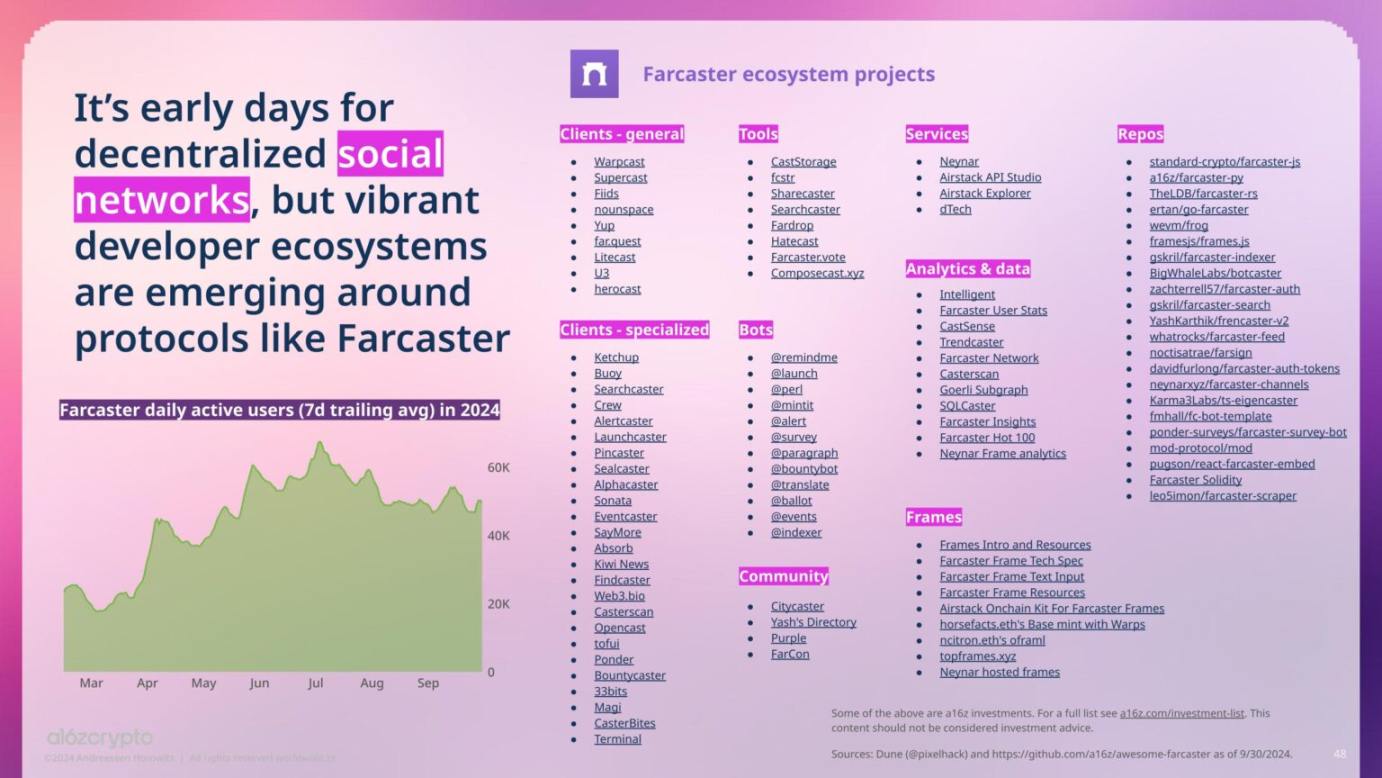
As builders and consumers explore social experiences, on-chain gaming is pushing blockchain scalability to its limits. The Rollup used by the Proof Of Play high-seas adventure role-playing game Pirate Nation has consistently consumed the most gas per second among all Ethereum Rollups.
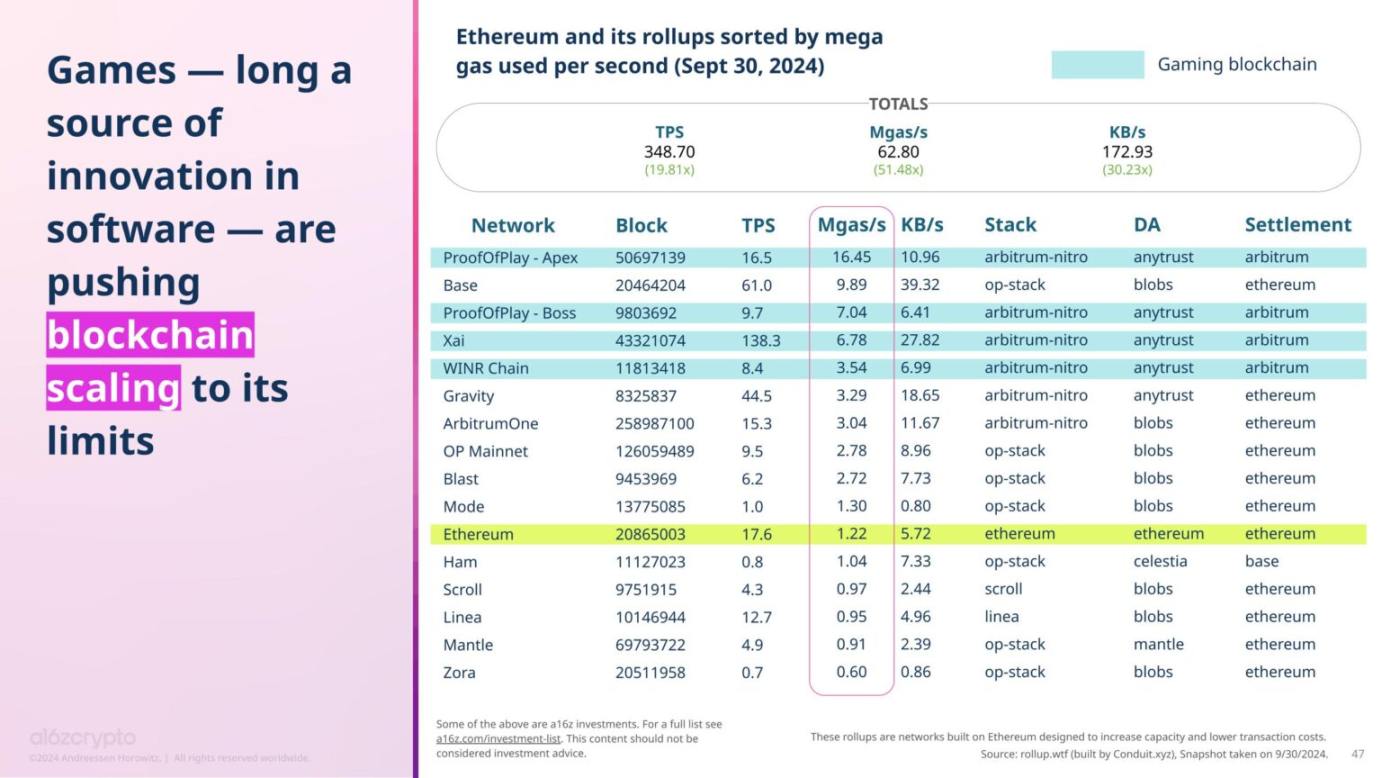
With the November elections approaching, the popularity of cryptocurrency-based prediction markets is rising (despite being illegal in the U.S.), and the overall momentum of prediction markets is strengthening. Kalshi, a non-crypto prediction market registered with the U.S. Commodity Futures Trading Commission, recently won a lawsuit regarding election contracts.
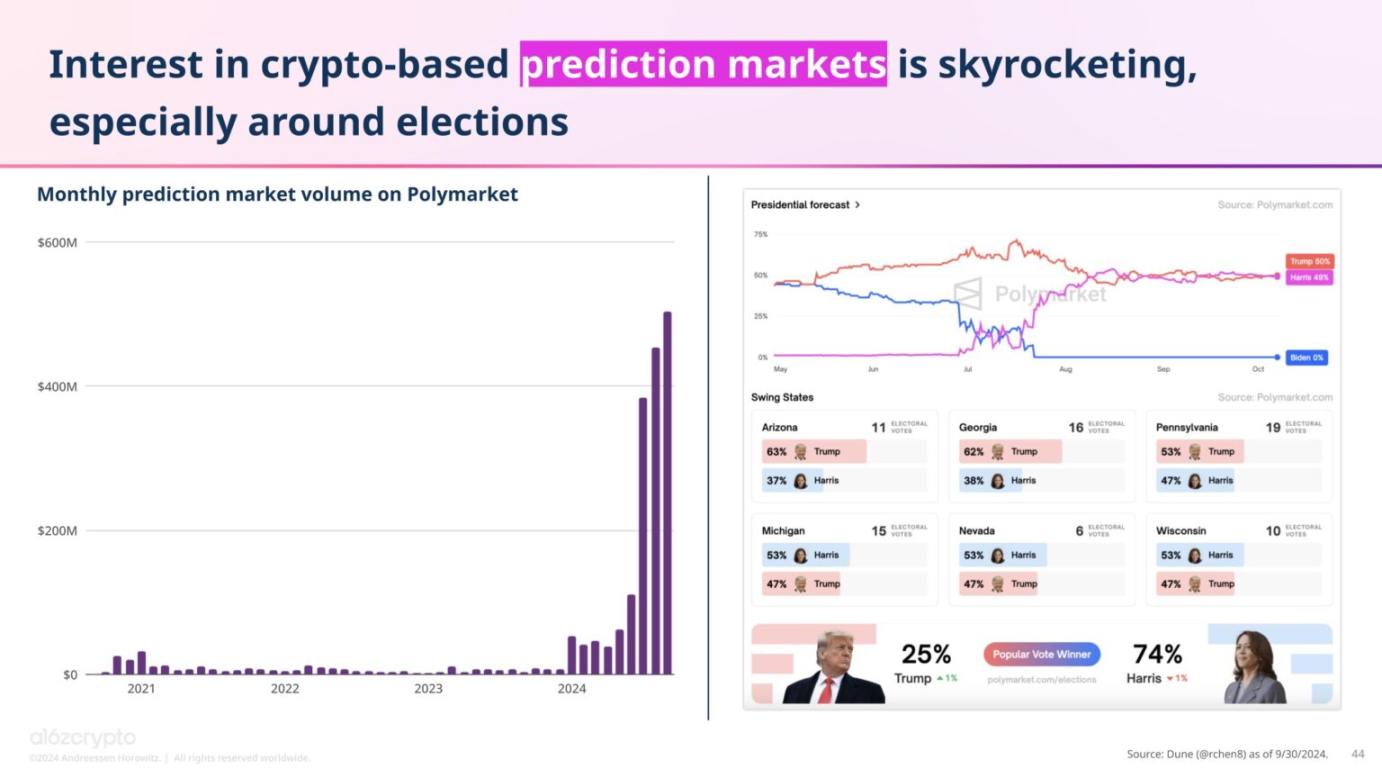
The emergence of new consumer behaviors has begun to manifest. All these emerging experiences have been difficult to achieve when blockchain infrastructure is cumbersome and transaction costs are high. As blockchain technology improves along the cost-performance curve, more such applications are expected to thrive.
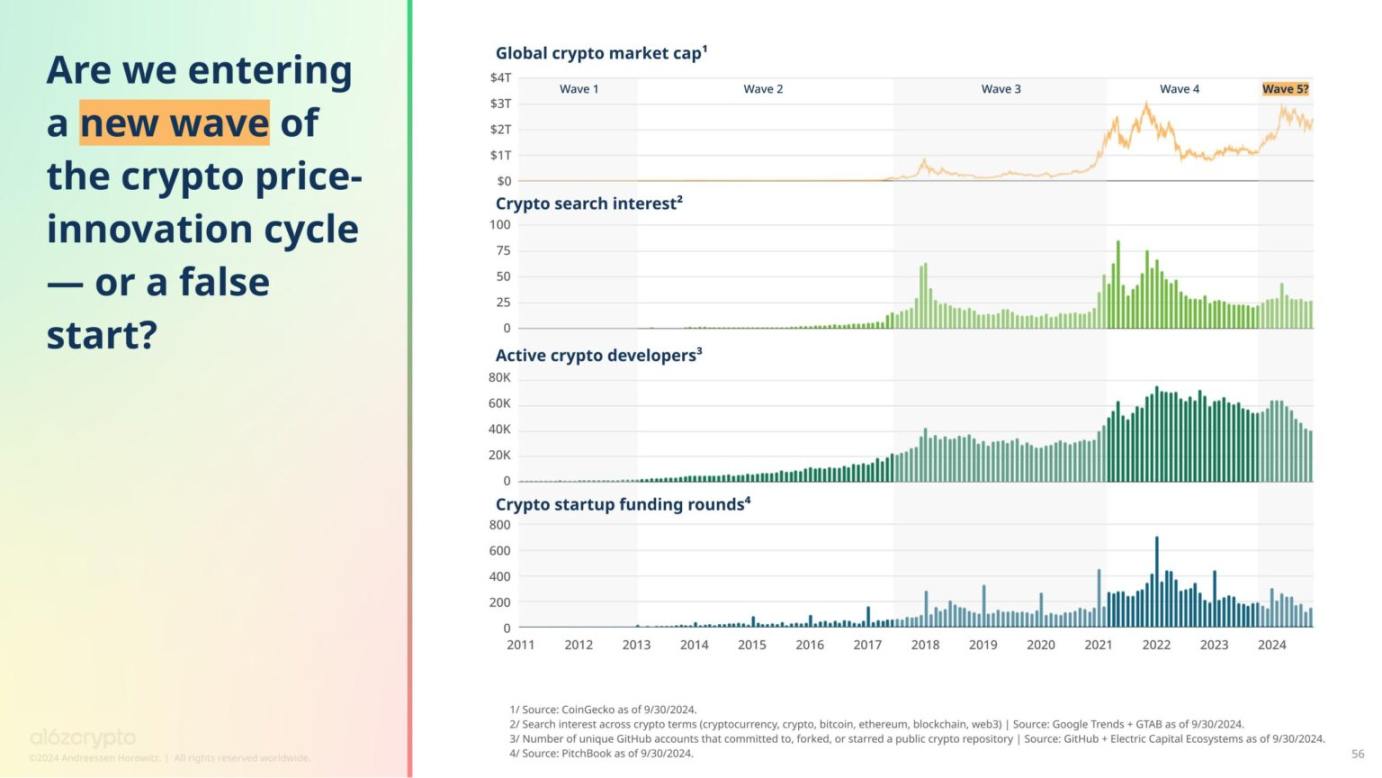
Summary
In the past year, cryptocurrency has made significant progress in policy, technology, and consumer adoption. On the policy front, there have been milestones, including the sudden approval of Bitcoin and Ethereum ETPs and the passage of important bipartisan legislation. Infrastructure has seen major improvements, from scaling upgrades to the rise of Ethereum Layer 2 and other high-throughput blockchains. New applications are continuously emerging and being utilized, from the growth of mainstream applications like stablecoins to explorations in emerging fields such as AI, social networks, and gaming.
免责声明:本文章仅代表作者个人观点,不代表本平台的立场和观点。本文章仅供信息分享,不构成对任何人的任何投资建议。用户与作者之间的任何争议,与本平台无关。如网页中刊载的文章或图片涉及侵权,请提供相关的权利证明和身份证明发送邮件到support@aicoin.com,本平台相关工作人员将会进行核查。




